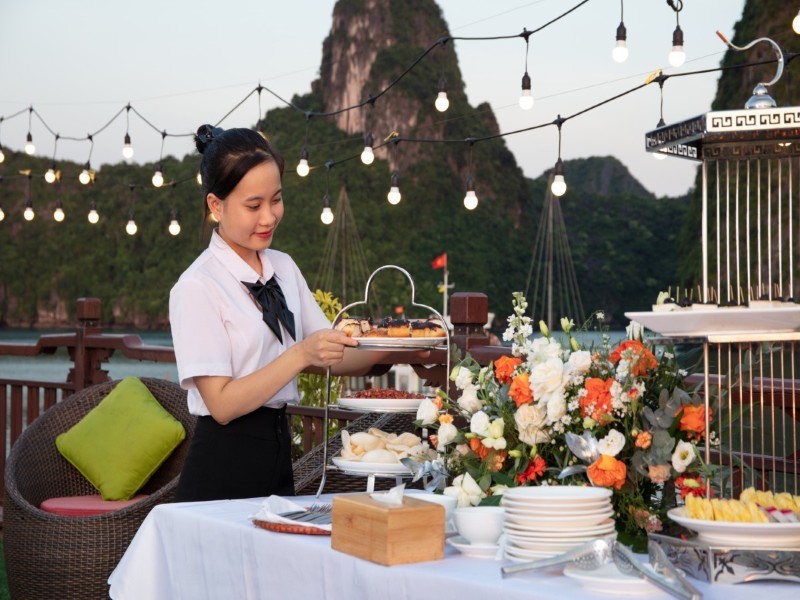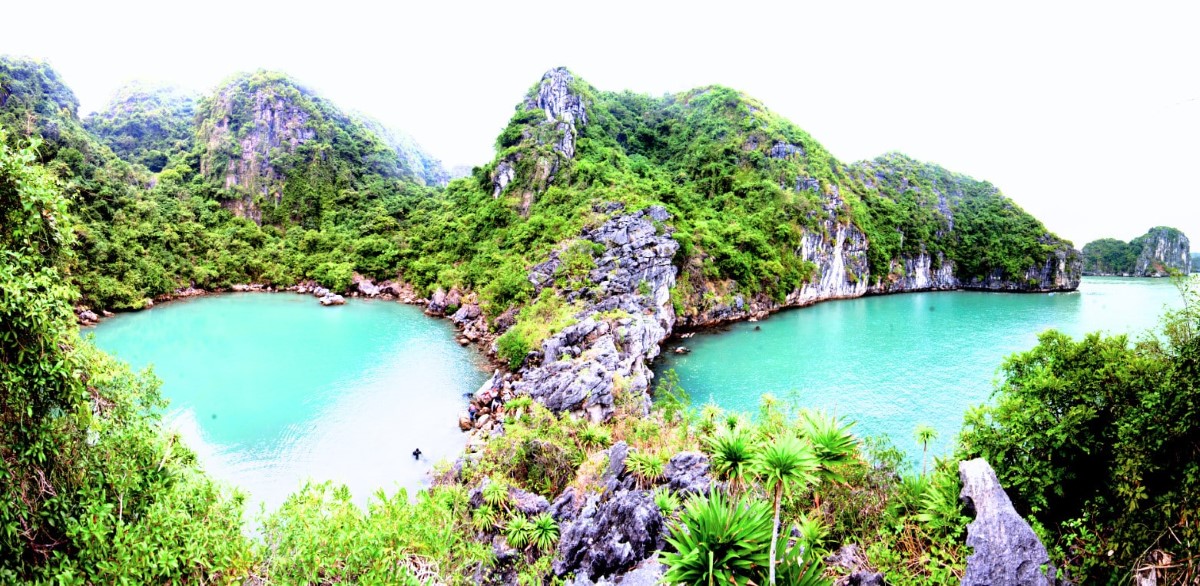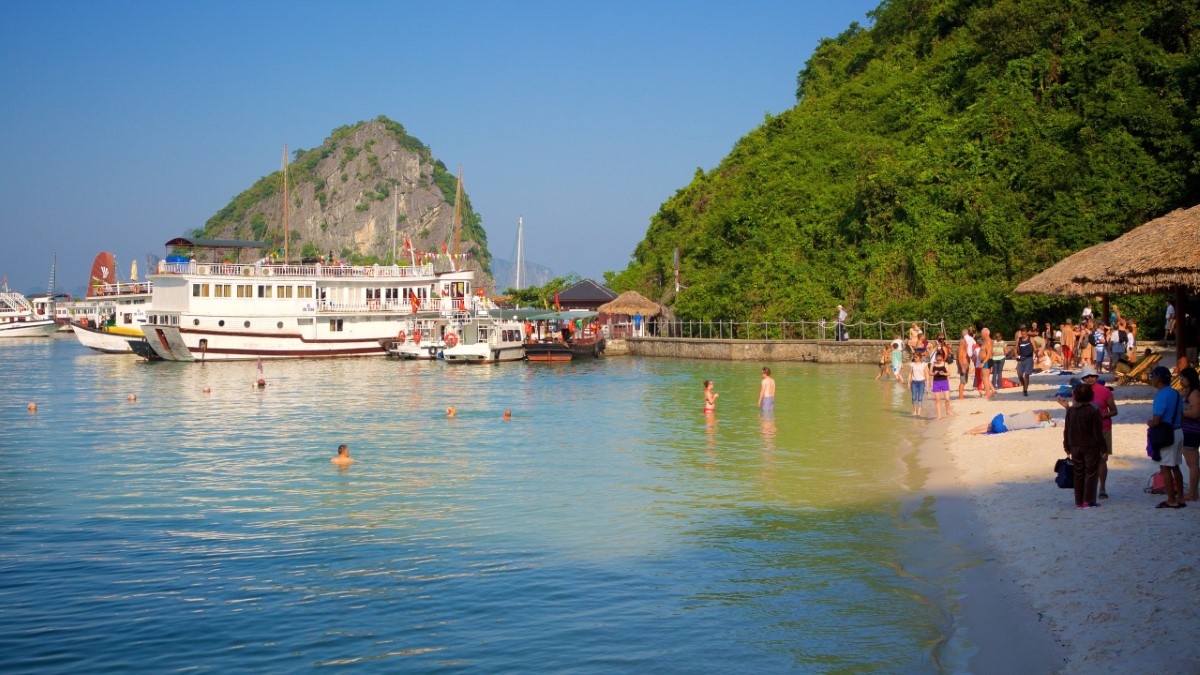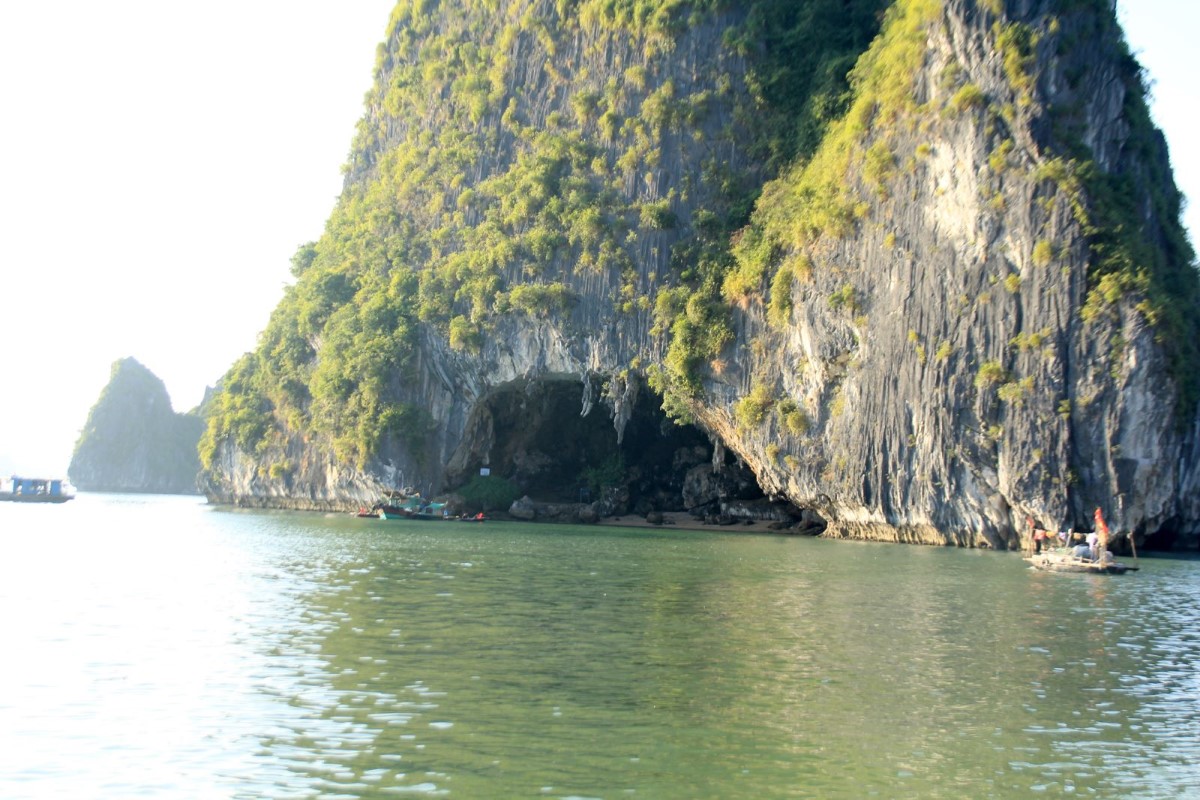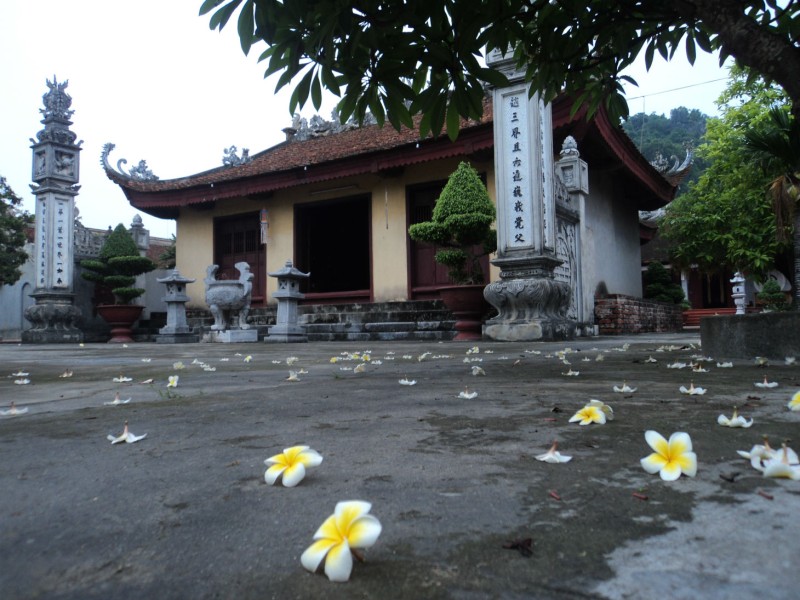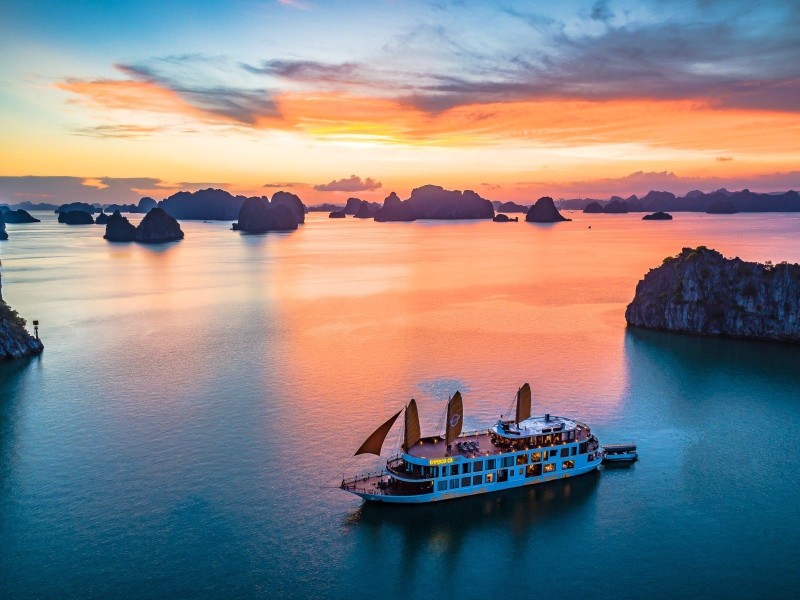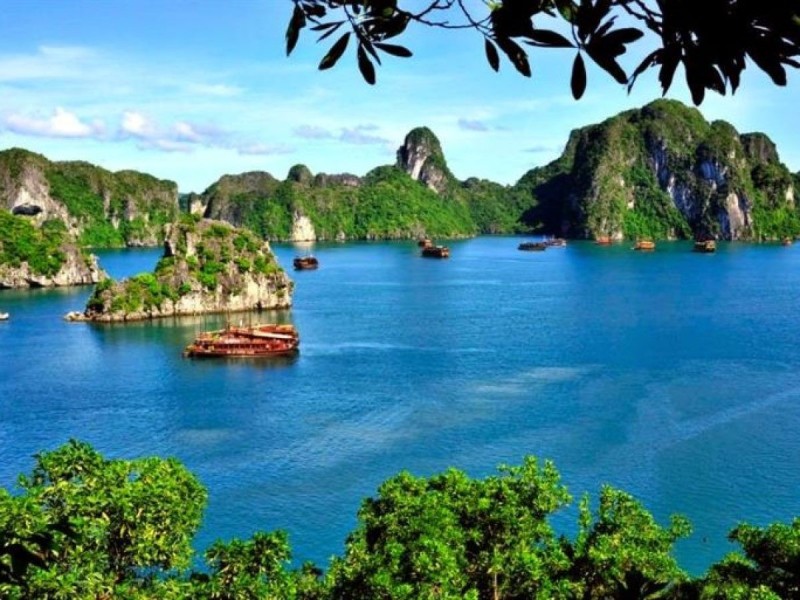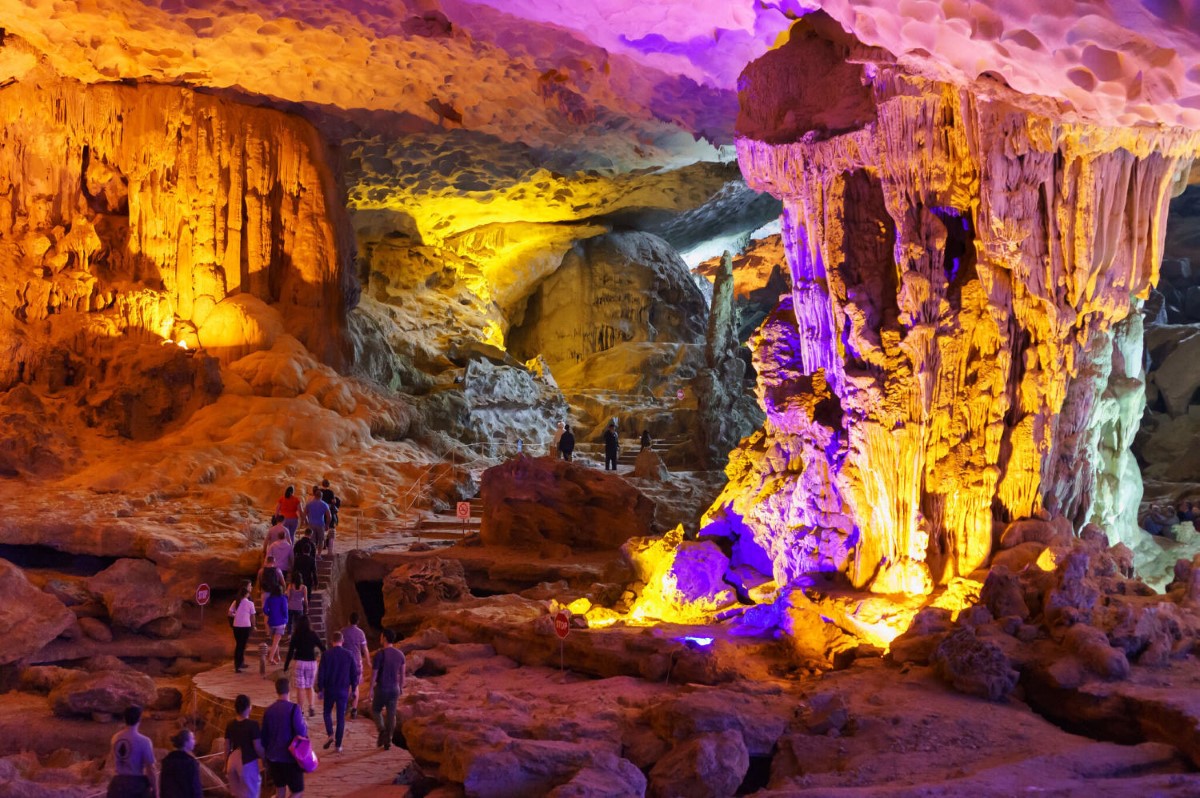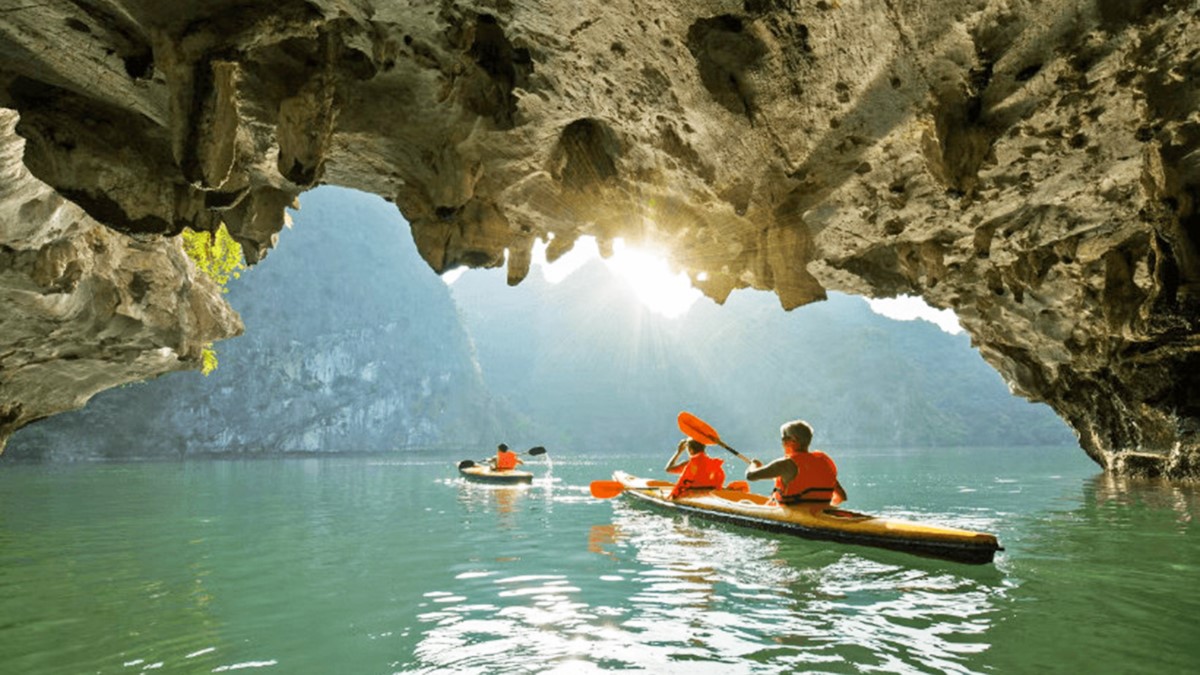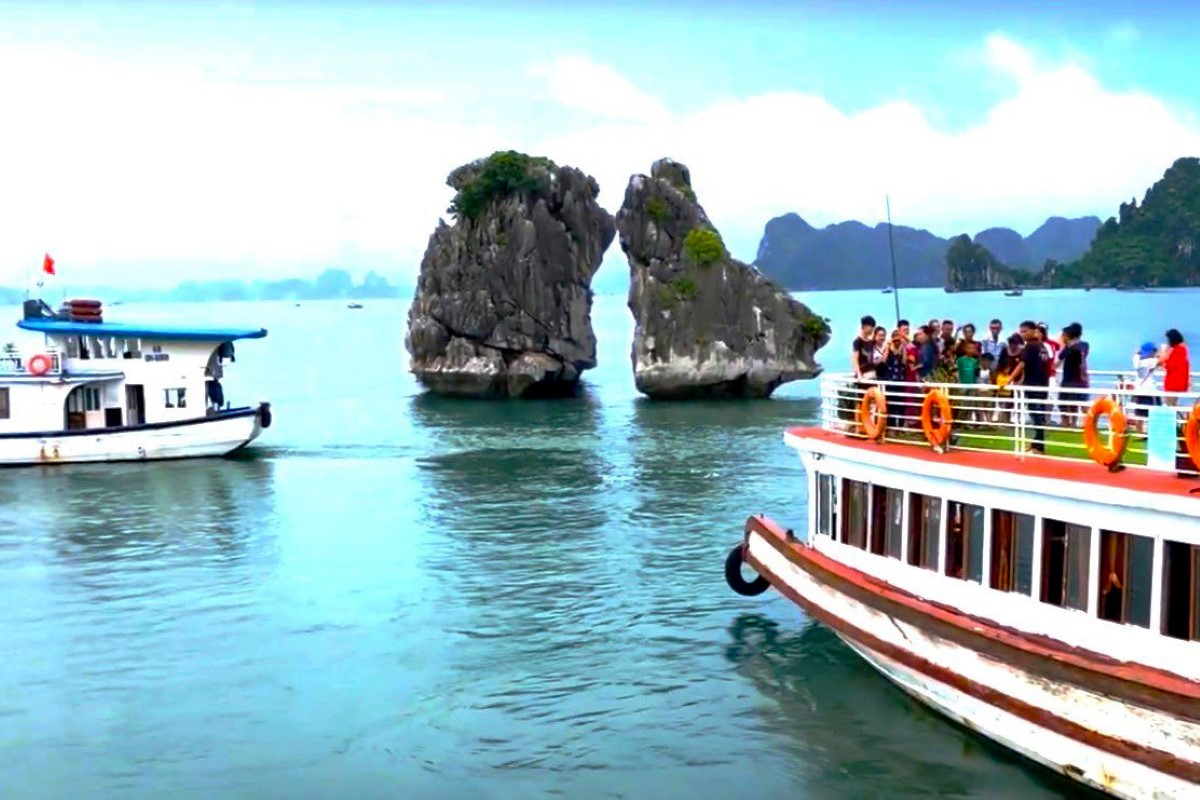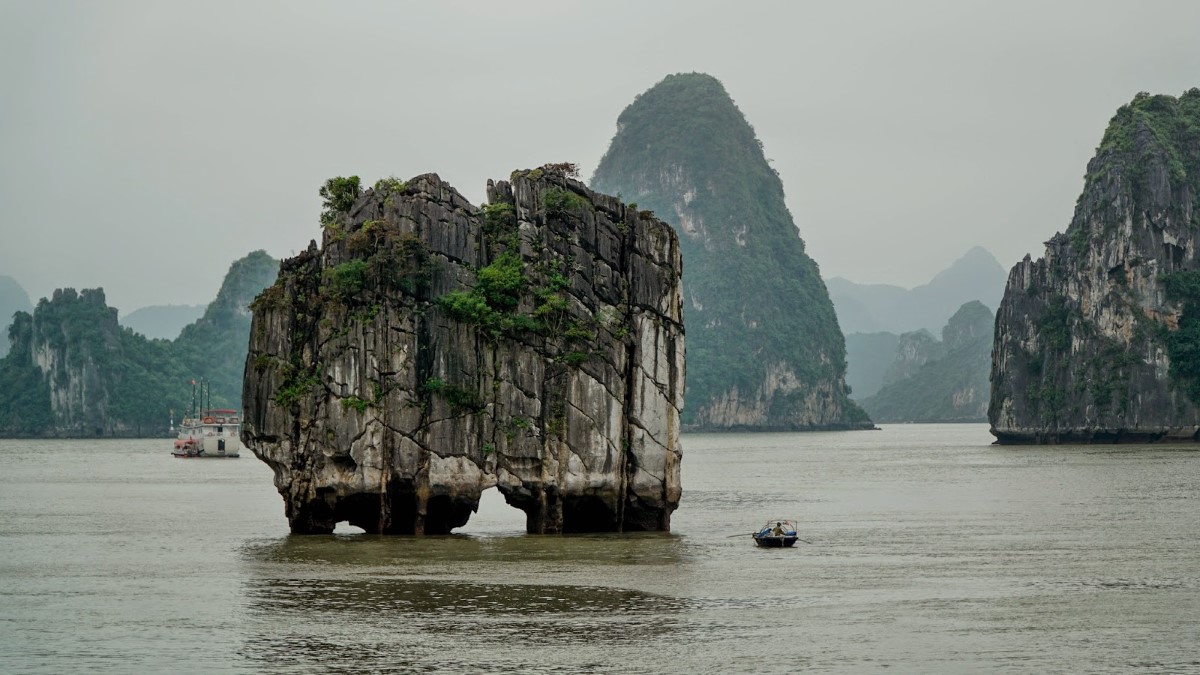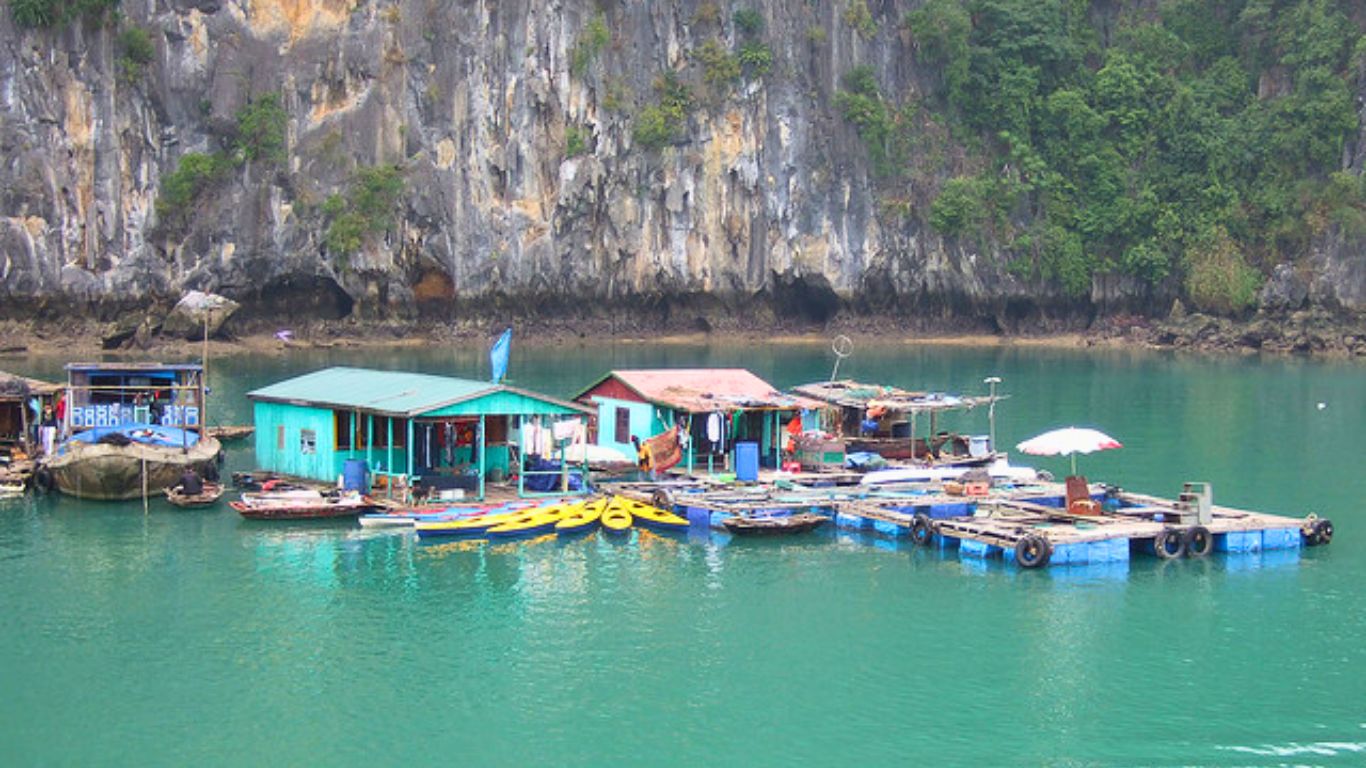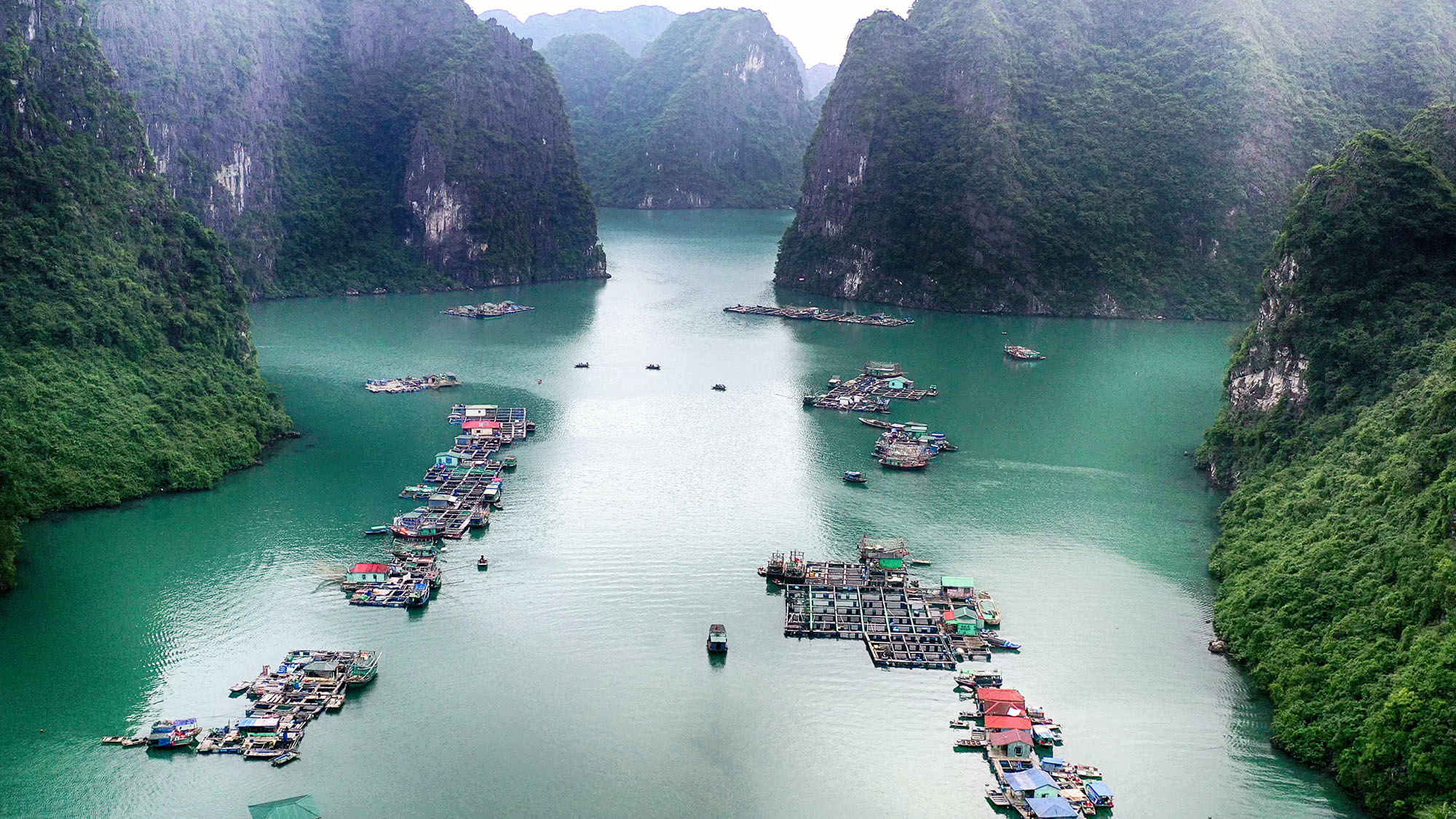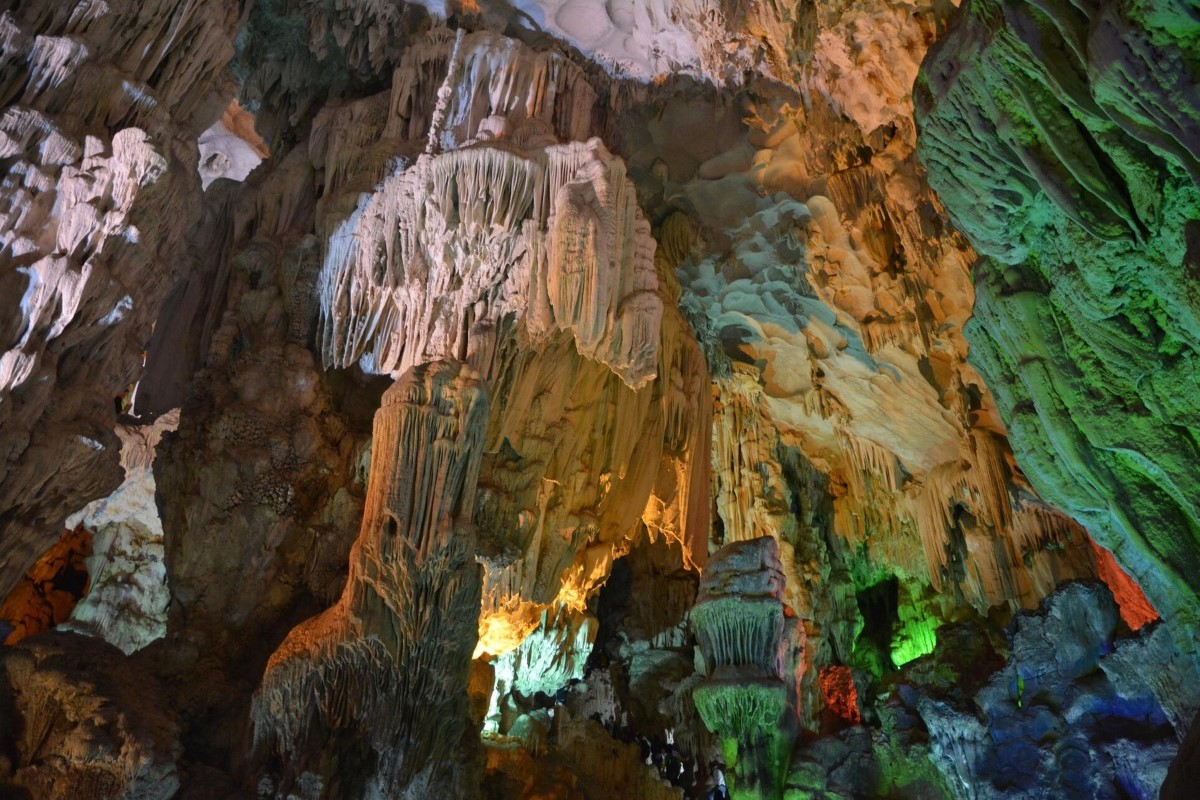Vung Vieng Fishing Village in Bai Tu Long Bay Authentic Travel Guide
Vung Vieng Fishing Village offers an authentic floating village experience in Bai Tu Long Bay, showcasing traditional Vietnamese fishing culture and stunning limestone karsts. Visitors enjoy peaceful boat tours, local pearl farming insights, and serene natural beauty away from crowded tourist spots.
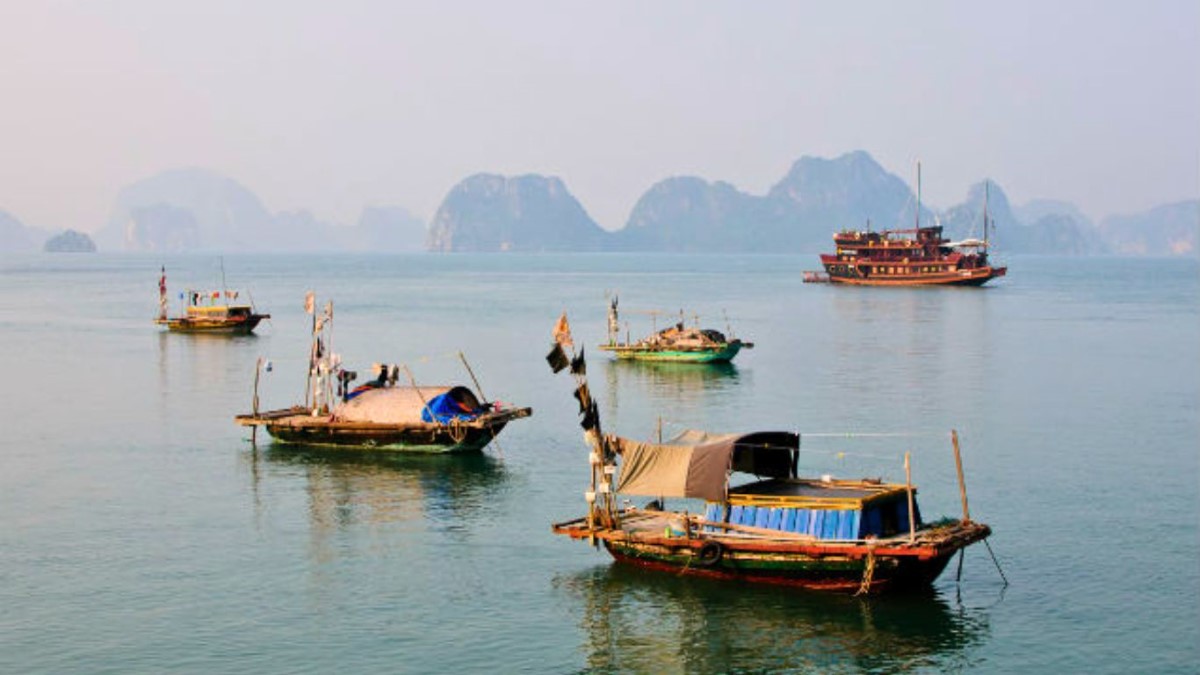
Discovering Vung Vieng Fishing Village
Nestled quietly within the pristine waters of Bai Tu Long Bay, Vung Vieng Fishing Village offers a rare glimpse into a way of life that has remained untouched by modern rush. This floating fishing village charms visitors with its serene atmosphere, where traditional wooden boats gently sway alongside simple stilt houses. The village pulses with a rich marine biodiversity and a genuine Vietnamese community spirit that invites you to slow down and experience authentic coastal living. Here, every corner tells a story shaped by the sea and generations of fishermen, making it a captivating destination for those seeking a true connection with Vietnam’s maritime heritage. Embrace the Vung Vieng charm and discover an authentic experience in Bai Tu Long Bay unlike any other.
This is a place where nature and tradition harmonize, offering you peaceful moments amid spectacular limestone karsts and thriving marine life. The floating fishing village remains a vibrant testament to enduring local customs in a rapidly changing world. Plan your visit to Vung Vieng Fishing Village today and immerse yourself in a floating community where time moves at the pace of the tides.
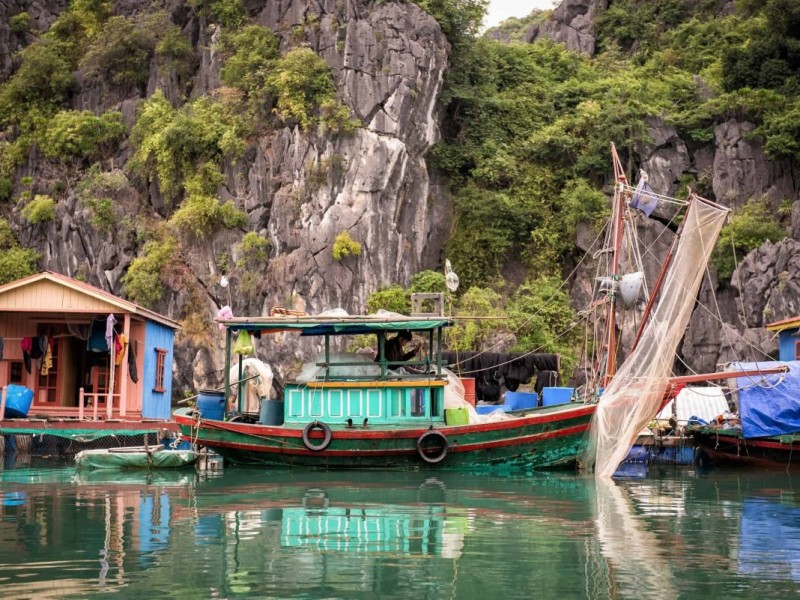
What Makes Vung Vieng Special?
The magic of Vung Vieng lies in its unspoiled natural beauty and the authentic community life that continues undisturbed by mass tourism. Unlike the busier spots in Halong Bay, Vung Vieng offers a tranquil retreat where the only sounds are the gentle lapping of water and the calls of seabirds. Visitors find a peaceful floating village where traditions thrive and the pace invites reflection and connection.
Key features that set Vung Vieng apart include:
- Unspoiled Nature: Clear waters, limestone karsts, and vibrant marine biodiversity provide stunning scenery far from crowded tourist paths.
- Genuine Community: A small, close-knit group of fishermen and families continue their daily routines with little outside interference.
- Tranquil Atmosphere: Absence of large cruise ships means more intimate experiences and serene surroundings.
- Contrast to Halong Bay: While Halong Bay is famous for bustling cruises, Vung Vieng offers solitude and an authentic fishing village feel.
Choose Vung Vieng if you seek a peaceful floating village that embraces tradition over tourism.
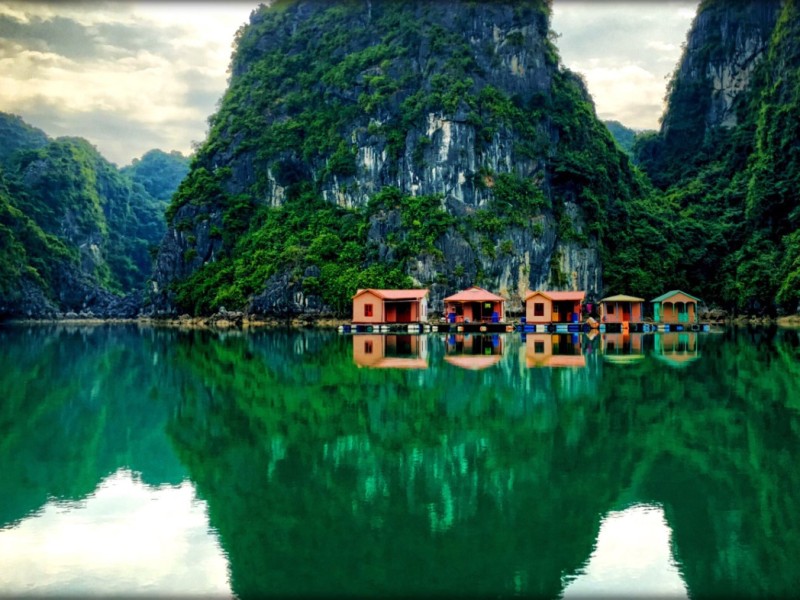
A Glimpse into the Village’s History and Culture
Vung Vieng's history is deeply tied to the sea, shaped by generations of families who have relied on fishing and pearl farming for their livelihoods. This floating village has preserved much of its traditional way of life, serving as a living example of Vietnam’s maritime heritage. Established centuries ago, the community grew around the abundant marine resources, developing fishing methods passed down through families and weaving rich cultural customs connected to the rhythms of the bay.
The floating village culture in Vietnam is unique in how it balances human life with nature’s ebb and flow. Vung Vieng stands as a testament to this harmony, where the local people maintain traditional homes on the water and celebrate festivals linked to the sea.
Understanding the village’s origins and enduring cultural practices deepens your appreciation for this hidden gem. Visiting here is not just sightseeing—it’s a chance to witness a heritage alive and thriving.
Traditional Fishing Practices and Lifestyle
The daily life of Vung Vieng villagers revolves around fishing traditions refined over generations. Their routines include early mornings casting nets and setting traps for crabs and fish, relying on methods like net casting and crab trapping that are both effective and sustainable. Life on the water means families share tight-knit bonds, with children learning the craft alongside elders.
Key aspects of the fishing lifestyle include:
- Net Casting: Villagers throw large nets into the bay to catch fish schools.
- Crab Trapping: Setting bamboo traps in strategic spots to catch crabs.
- Family Life on Water: Multi-generational households live and work closely in floating homes.
- Sustainable Practices: Fishing methods designed to preserve marine biodiversity.
Experiencing this traditional way of life offers insight into a culture shaped by the sea and community resilience.
Mr. Binh's Daily Catch: Insights from a Vung Vieng Fisherman
Most travel guides tell you about a place, but my recent journey to Vung Vieng Fishing Village wasn't just about seeing; it was about truly feeling the rhythm of life on the water, particularly through the calloused hands and knowing eyes of Mr. Binh. This wasn't merely observing traditional fishing; it was a rare glimpse into a soul intertwined with the ebb and flow of Bai Tu Long Bay, revealing truths about resilience and connection that no brochure could ever capture.
The pre-dawn mist hung thick over the jade-green waters as my small bamboo sampan glided silently towards Mr. Binh's humble floating home. A subtle scent of salt and damp wood filled the air, mixed with a faint aroma of brewing Vietnamese coffee. My initial expectation was a simple demonstration, but as Mr. Binh, a man whose face was etched with sun and smiles, began to prepare his nets, I realized this was his life's symphony, not a performance. He moved with an effortless grace, his movements practiced over decades, each knot tied with quiet precision. The rhythmic swish of the water against the boat and the distant cry of gulls were the only sounds as dawn's first light painted the sky in soft oranges and purples, turning the towering limestone karsts into majestic silhouettes. There was a profound sense of peace, a tranquility that seeped into my very bones, completely unlike the bustling energy of Hanoi.
As we pushed off, the sunrise erupted, splashing the bay with gold. Mr. Binh, with a glint in his eye, began to explain his morning ritual, his Vietnamese interspersed with gestures and a few patient English words. He spoke of reading the water, understanding the tides, and knowing where the fish would be hiding. "The bay, she speaks to us," he chuckled, his voice raspy from years of calling out over the water. He demonstrated casting his net – a sweeping, elegant arc that sent the mesh unfurling gracefully over the water, shimmering for a moment before disappearing beneath the surface. The tension in the line was palpable, and I could feel his anticipation, a mix of hope and the acceptance of nature's unpredictability. When he pulled in the net, revealing a handful of shimmering, silver fish, his smile was genuine and infectious. It wasn't about the quantity; it was the satisfaction of the chase, the respect for the bounty. He pointed out different species, explaining their habits. His expertise wasn't just learned; it was lived. There was a moment when a small, iridescent crab scuttled across the bottom of the boat, and Mr. Binh, instead of simply tossing it back, held it up, explaining its unique markings before gently releasing it, a silent testament to his deep respect for the ecosystem. This wasn't just a job; it was a partnership with the bay.
What struck me most was the sheer dedication and simple joy in his work. In a world chasing efficiency, Mr. Binh's approach was a masterclass in patience and harmony. He wasn't battling nature; he was flowing with it. This experience offered me a profound appreciation for the interconnectedness of their lives with the bay and revealed the deep-seated pride they have in their heritage. It was an insight into sustainability long before the word became a buzzword, simply born of necessity and respect.
Here are some practical takeaways if you seek this authentic connection:
- Go Early: Aim for a pre-dawn or very early morning start. The light is magical, the air is cool, and you'll witness the village waking up, which is a truly special moment.
- Embrace Silence: Vung Vieng is incredibly peaceful. Resist the urge to fill every moment with chatter. Listen to the sounds of the water and the gentle movements of the village.
- Engage Respectfully: Learn a few basic Vietnamese phrases ("Xin chào" - hello, "Cảm ơn" - thank you). A smile and genuine curiosity go a long way. Ask permission before taking close-up photos of individuals.
- Choose a Reputable Tour: Opt for a small-group tour or private sampan experience through your reputable cruise operator. This ensures you're supporting ethical practices and maximizing your chance for authentic interaction.
- What to Bring: A good camera (with a waterproof bag!), sun hat, light layers (it can be cool in the morning), and an open mind.
Leaving Vung Vieng, the scent of salt and the memory of Mr. Binh’s smile lingered. This wasn't just a visit to a floating village; it was a journey into the heart of a community, guided by someone who embodies its very essence. It's a reminder that the richest travel experiences aren't always found on the main tourist trails, but in the quiet, shared moments with local people whose lives are truly unique.
Recommendation: For anyone yearning for a truly authentic, soulful encounter in Vietnam, one that transcends typical sightseeing and offers a profound human connection, I wholeheartedly recommend seeking out a "Mr. Binh" of your own in Vung Vieng. It's an experience that will stay with you long after you've left the tranquil waters of Bai Tu Long Bay.
The Role of Pearl Farming in the Community
Pearl farming is a vital part of the economy and culture in Vung Vieng. The process begins with oyster cultivation, where oysters are carefully nurtured in the bay’s clean waters. Farmers implant tiny beads inside the oysters, which over time develop into pearls. This delicate procedure requires patience and expertise passed down through generations. Pearl farming not only supports many families in Vung Vieng but also sustains the local economy of Bai Tu Long Bay by providing a unique product sought after both domestically and internationally.
Key stages of pearl farming include:
- Oyster Cultivation: Collecting and growing oysters in floating nets or cages within the bay.
- Nucleation Process: Implanting beads into oysters to trigger pearl formation.
- Harvesting Pearls: After several months to years, pearls are carefully extracted.
- Economic Impact: Provides income and employment for local families and contributes to regional trade.
Understanding this process offers a window into how Vung Vieng pearl farm operations maintain a balance between tradition and economic survival.
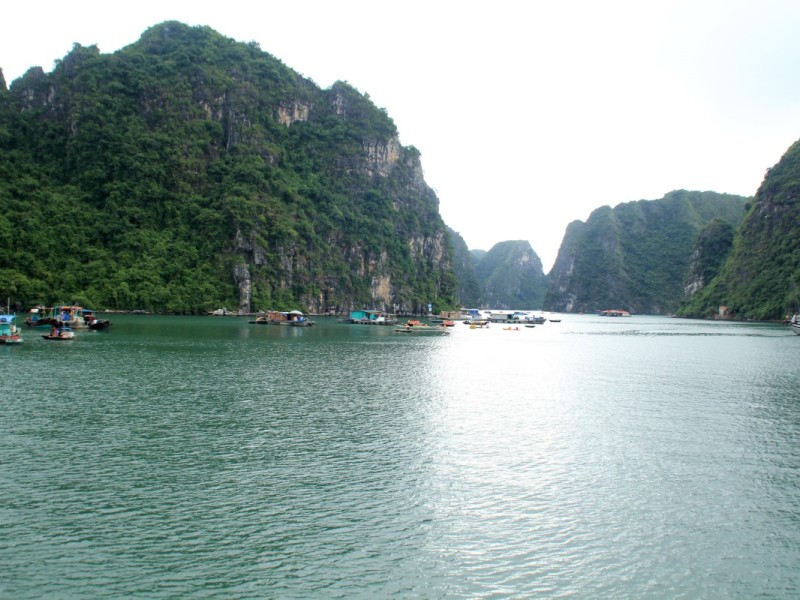
How the Village Fits into Bai Tu Long Bay’s Natural Landscape
Vung Vieng is beautifully nestled within the serene waters of Bai Tu Long Bay, where the village’s floating homes and boats seem to float effortlessly among the stunning natural surroundings. The village harmonizes with the bay’s unique geological features, particularly the towering limestone karsts that rise dramatically from the water. These formations create sheltered waters that protect the community from harsh weather and provide a breathtaking backdrop for visitors. The calm marine ecosystem around Vung Vieng supports a diverse range of aquatic life, contributing to the village’s way of life and the local fishing practices. This harmonious integration between culture and nature makes Vung Vieng natural beauty a captivating experience.
Unique Limestone Karsts and Marine Biodiversity
The geological marvels of Bai Tu Long Bay surround Vung Vieng, featuring stunning limestone karsts that have been sculpted over millennia. These karsts create a maze of islands and caves, making the area a haven for marine biodiversity. The bay is home to a variety of fish species, colorful corals, and other marine creatures that thrive in its clean, calm waters. This rich ecosystem plays a crucial role in supporting the local fishing economy and offers visitors a chance to witness nature’s wonders up close.
Key highlights include:
- Limestone Karsts: Towering rock formations that shape the bay’s dramatic landscape.
- Marine Life: Diverse species of fish, crustaceans, and coral reefs found in the surrounding waters.
- Biodiversity Significance: An important ecological area contributing to Vietnam’s natural heritage.
Exploring the limestone karsts and marine life enhances your understanding of Vung Vieng’s place within this unique environment.
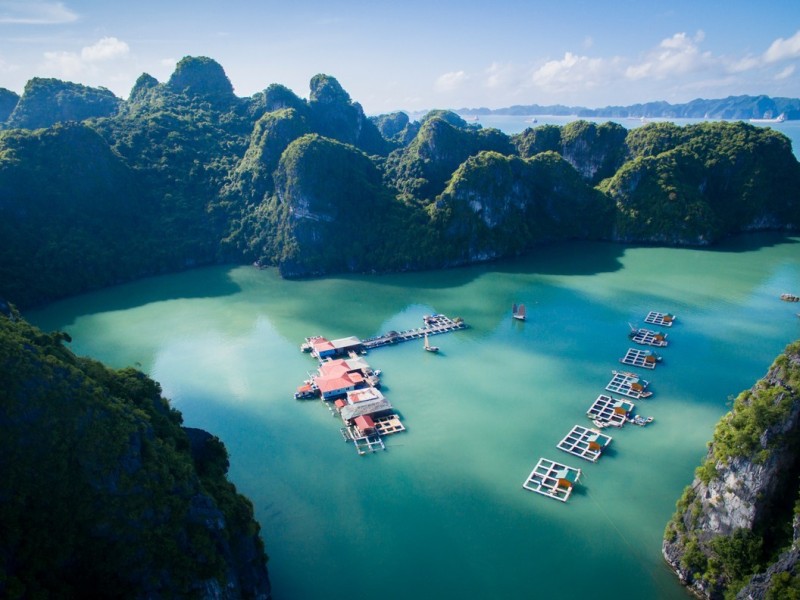
Preparing for Your Authentic Vung Vieng Adventure
Preparing well before your trip is key to fully enjoying the unique charm of Vung Vieng Fishing Village. This section provides essential pre-trip planning steps, covering everything from packing lists to understanding local customs. Proper preparation ensures your visit to Bai Tu Long Bay is smooth, stress-free, and enriching. You’ll learn how to pack smart, respect local culture, and arrange your travel to maximize your experience.
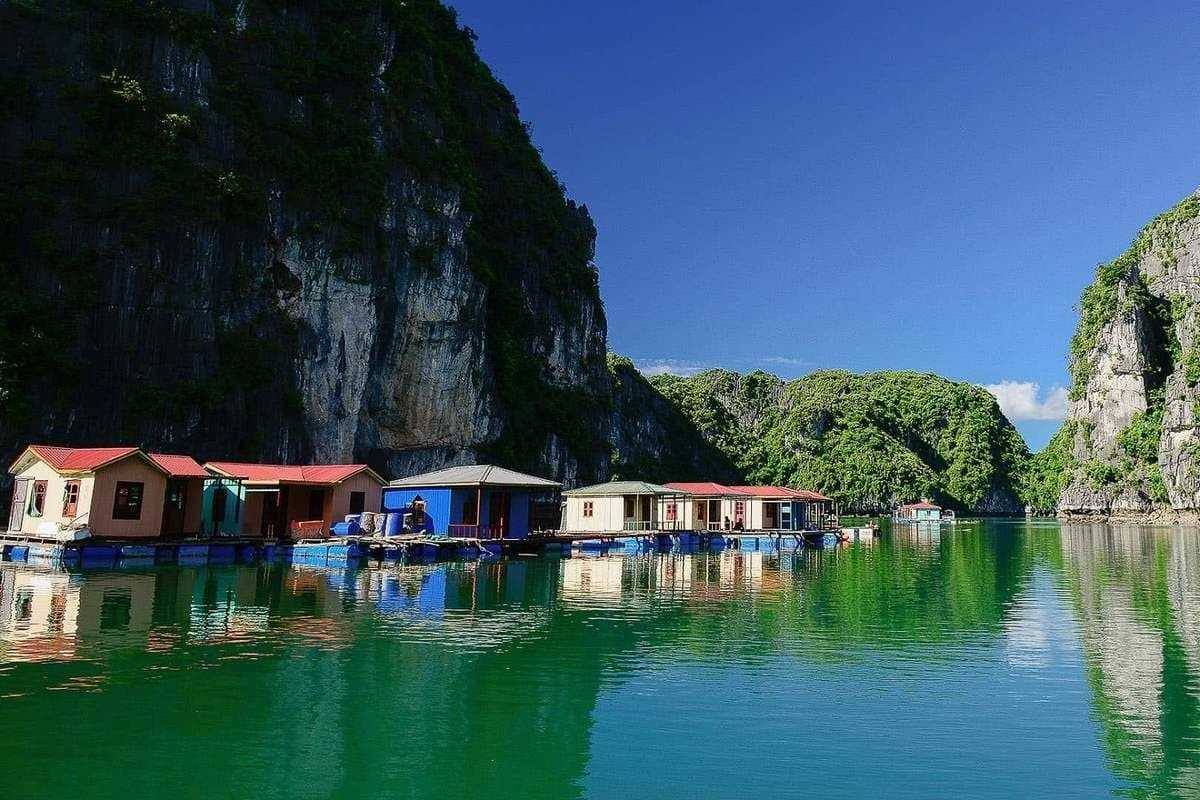
Choosing the Right Tour Operator for Vung Vieng
Selecting the right tour operator is essential for an authentic and rewarding visit to Vung Vieng Fishing Village. The best operators offer small group experiences that avoid overcrowding and promote respectful interaction with the local community. Prioritize companies that follow eco-friendly practices to help preserve the natural beauty and fragile environment of Bai Tu Long Bay. Look for clear, detailed itineraries that include meaningful stops in Vung Vieng and surrounding areas.
Before booking, check reviews from past travelers to ensure reliability and quality. Ethical tour operators will be transparent about their commitment to sustainability and community support, including fair wages for local guides and contributions to cultural preservation projects. Ask about group sizes, environmental policies, and how the operator engages with villagers to confirm your tour aligns with your values.
By choosing a responsible and reputable tour operator, you’ll enjoy a more personal and immersive experience, helping protect the village’s charm for future visitors. Planning with care ensures your adventure in Vung Vieng is both memorable and mindful.
Emily's Insight: Navigating Tour Options for Vung Vieng
Choosing a Halong Bay cruise that included Vung Vieng was, surprisingly, one of the most involved parts of my trip planning. There are so many options, and a quick search can leave you feeling overwhelmed. My goal wasn't just to see the famous limestone karsts; I wanted a genuine connection, something beyond the typical tourist postcard. I was specifically looking for a tour that prioritized small group sizes, offered authentic interactions with locals, and ideally, demonstrated a commitment to sustainability. This quest felt a bit like finding a needle in a haystack, but the payoff was absolutely worth it.
My journey began with scrolling through countless online reviews and comparing itineraries. I quickly noticed a trend: many tours promised Vung Vieng but often rushed through it or offered only a superficial glimpse. Red flags started popping up, like cruise lines with suspiciously low prices (which often hide extra charges or compromise on quality and safety) or those that seemed to cram too many activities into one day. I also watched out for cruises that focused solely on Halong Bay's most crowded areas. While beautiful, I craved the quieter, more authentic experience I imagined Vung Vieng would offer.
What truly guided my decision was seeking out tours that explicitly mentioned Bai Tu Long Bay. This area, adjacent to the more famous Halong Bay, is known for being less crowded and having a stronger focus on local life and environmental preservation. It was in searching for Bai Tu Long Bay cruises that I started finding smaller, more boutique operators. I prioritized those with clear descriptions of their Vung Vieng activities – not just a drive-by, but opportunities for kayaking or bamboo boat rides rowed by locals. This was crucial for me; I wanted to support the community directly. I also looked for mentions of "community-based tourism" or "local engagement," which hinted at a more responsible approach.
Ultimately, I chose a 2-day, 1-night cruise that specifically advertised an excursion to Vung Vieng via a smaller transfer boat, allowing us to venture deeper into the village. The "unexpected benefit" was how genuinely passionate the staff were about the local culture and the bay itself. Our guide shared stories about the families, the challenges they faced, and their efforts to maintain their traditional way of life. It felt less like a scripted tour stop and more like being invited into their world. The smaller group size on the transfer to the village meant we could ask questions, linger a bit longer, and truly soak in the atmosphere without feeling rushed or like we were part of a massive, disruptive crowd. It reinforced my belief that sometimes, less is truly more when it comes to travel.
Here are my actionable practical takeaways for choosing your Vung Vieng tour:
- Prioritize Bai Tu Long Bay: If an authentic, less crowded experience is your goal, look for cruises that operate specifically in Bai Tu Long Bay, as Vung Vieng is typically a highlight there.
- Check Vung Vieng Activity Details: Don't just assume "visit Vung Vieng" means an immersive experience. Look for descriptions that mention kayaking, bamboo boat rides rowed by locals, or opportunities for cultural exchange.
- Opt for Smaller Groups: Larger cruises can feel impersonal. Seek out tours that explicitly state small group sizes for a more intimate and less impactful visit to the village.
- Read Recent Reviews Carefully: Pay attention to what other travelers say about their Vung Vieng experience on specific cruises. Look for mentions of genuine local interaction and environmental responsibility.
- Beware of "Too Good to Be True" Prices: Extremely cheap tours often come with hidden costs or compromised experiences. Research average prices to set realistic expectations.
- Look for Sustainability Claims: While hard to verify perfectly, tours that mention efforts towards environmental protection or direct support for local communities are usually a good sign.
In the end, my decision wasn't just about booking a trip; it was about curating an experience that resonated with my desire for connection and responsible travel. The insight I gained into Vung Vieng's unique way of life, made possible by a carefully chosen tour, was truly invaluable.
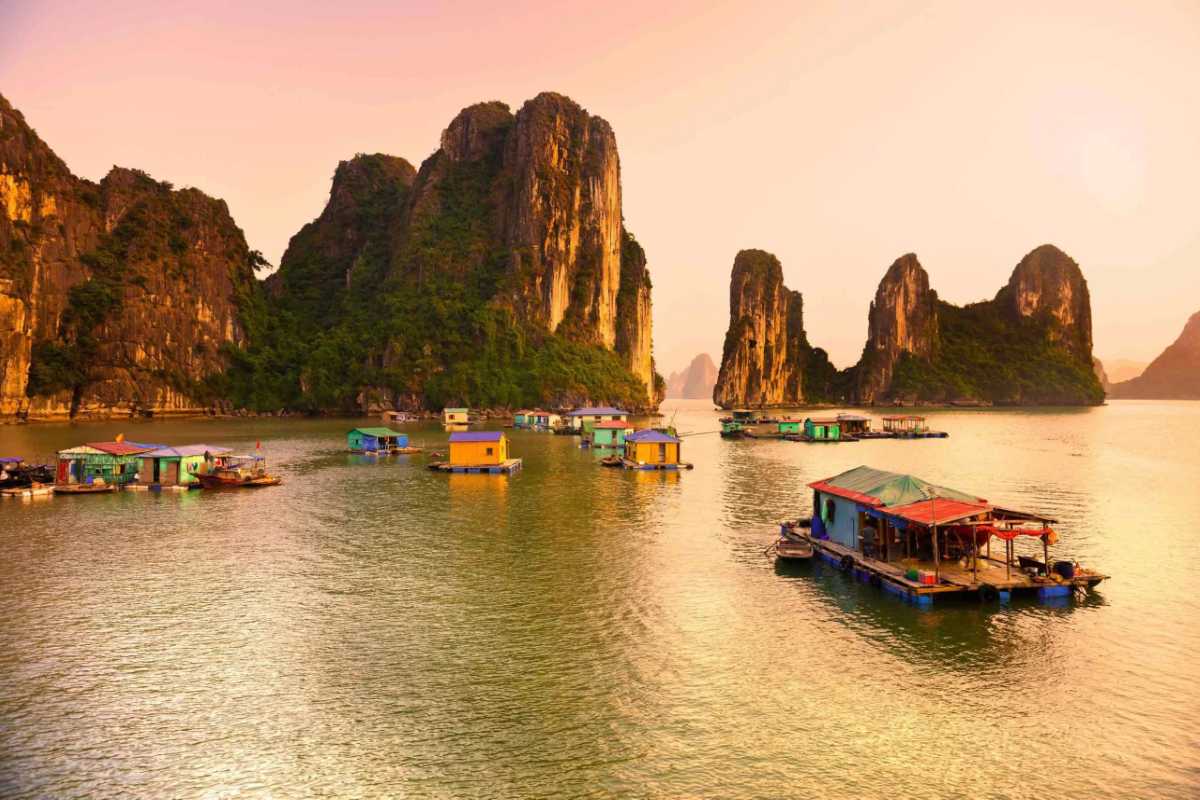
Budgeting for Your Vung Vieng Trip: A Cost Breakdown
Planning your finances is a crucial part of visiting Vung Vieng Fishing Village. Knowing the typical costs helps you prepare a realistic Vung Vieng travel budget and avoid surprises. Here’s a breakdown of the main expenses you should expect during your trip to Bai Tu Long Bay.
Transportation
- From Hanoi to Halong or Van Don by bus or private car: $10–$40
- Boat or cruise transfers to Vung Vieng: $20–$100, depending on boat type and trip duration
Tour Packages
- Day tours including Vung Vieng: $50–$100 per person
- Overnight cruises with meals and activities: $100–$300+ per night
Activities
- Kayaking rentals: $10–$20 per hour
- Local fishing experiences: $15–$30 per session
Food
- Meals in floating village or on board: $5–$15 per meal
- Snacks and drinks: $1–$5 each
Souvenirs
- Handcrafted items and pearls: $5–$50 depending on quality and size
Tips and Miscellaneous
- Tips for guides and boat crew: $5–$10 per day
- Miscellaneous expenses: $10–$20 for emergencies or extras
By budgeting carefully across these categories, you can enjoy your trip without financial stress. Planning ahead with a clear cost of visiting Vung Vieng ensures you get the most out of your Bai Tu Long Bay tour price.
David's Dollars: Making the Most of Your Vung Vieng Budget
When I started planning my trip to Vung Vieng, I envisioned an idyllic, off-the-grid escape, and while it delivered on that front, I also knew I needed to be smart about my spending. "Floating village" sounded like it could be either dirt cheap or surprisingly expensive. My aim was to experience the true essence of Vung Vieng without breaking the bank, finding that sweet spot of value for money. It wasn't about being stingy, but about making conscious choices to ensure my limited funds stretched as far as possible for authentic experiences.
My biggest expenditure, as expected, was the cruise package that included Vung Vieng. I opted for a 2-day, 1-night Bai Tu Long Bay cruise which specifically featured Vung Vieng. While there were cheaper Halong Bay options, I paid a bit more (around $150-200 USD for a mid-range cruise) for the promise of less crowds and a more authentic itinerary in Bai Tu Long Bay, which was a splurge I found absolutely worthwhile. This price typically covered transportation from Hanoi, all meals on board, cabin accommodation, and guided activities like kayaking and the bamboo boat ride in Vung Vieng. This all-inclusive approach eliminated many hidden costs and provided excellent value.
One small, unexpected cost was the drinks onboard the cruise. While meals were included, beverages (soft drinks, beer, wine) were extra and, as expected, marked up. I wasn't going to miss out on a cold local beer while watching the sunset, so I factored that in. Also, while most activities within Vung Vieng (like the bamboo boat ride) were part of the tour, if you desired a very extended kayak session beyond the tour’s allotted time, or wanted to hire a local boat for a private exploration, those would be additional. For food within the village itself, there are very few, if any, commercial eateries. Any meals you experience there are almost certainly part of your cruise's arranged activities or a homestay.
Saving money was relatively easy once the main cruise was booked. Since Vung Vieng is a small, isolated community, there aren't many opportunities for impulsive spending. My main budget hacks revolved around:
- Packing Smartly: Bringing my own reusable water bottle was a huge win. Many cruises provide water, but having my own meant I wasn't buying plastic bottles, which helps both my wallet and the environment. I also packed enough snacks for the journey to and from the bay, avoiding overpriced convenience store stops.
- Embracing Local Transport to the Port: While some cruises offer luxury limousine transfers from Hanoi, I chose the standard shuttle bus provided by my tour operator. It was comfortable enough and significantly cheaper than a private car.
- Mindful Souvenir Shopping: I found that souvenirs in Vung Vieng itself were quite limited to items like local pearls (which are a bigger investment) or small handmade crafts. Instead of feeling pressured to buy there, I waited to do my main souvenir shopping in Halong City or back in Hanoi, where prices were more competitive and there was a wider selection. I did, however, buy a beautiful, simple woven mat from a local woman in Vung Vieng, knowing it directly supported her. That felt like the perfect "splurge."
- Focusing on Experiences, Not Possessions: The true value of Vung Vieng is in the authentic interactions and the stunning natural beauty. I prioritized participating in every activity offered – kayaking, the bamboo boat, simply observing daily life – over seeking out expensive add-ons.
My visit to Vung Vieng didn't require constant budget vigilance once I had secured the right tour. The key was in the initial research and committing to a cruise that delivered on value, allowing the natural simplicity of the village to dictate the rest of my spending. It proved that an "authentic" experience doesn't necessarily mean "expensive"; it means choosing wisely and appreciating the true wealth of the destination.
Here are my actionable practical takeaways for making the most of your Vung Vieng budget:
- Choose an All-Inclusive Cruise: For Bai Tu Long Bay, a 2-day/1-night cruise typically covers transport, meals, accommodation, and core activities, offering the best overall value and predictability for your budget.
- Research Cruise Inclusions Carefully: Confirm what's not included (e.g., drinks, optional activities, tips) to avoid unexpected charges.
- Bring Your Own Essentials: Pack a reusable water bottle, snacks for transit, and any personal items you might need. Purchasing these on board can add up.
- Prioritize Experience Over Purchases: The most memorable parts of Vung Vieng are free – the views, the tranquility, the interactions. Focus your budget on the quality of your tour experience rather than material goods.
- Consider Transport Options: While a cruise package often includes transfers from Hanoi, ensure it's a shared shuttle if you're on a tighter budget; private transfers will be significantly more expensive.
- Factor in Tips: It’s customary to tip cruise staff and local rowers, so set aside a small amount for this.
Recommendation: If you're planning a trip to Vung Vieng, focus your budget on selecting a reputable Bai Tu Long Bay cruise that aligns with your desire for authenticity. Once that's sorted, you'll find that the true treasures of this floating village are priceless, and managing your remaining budget will be delightfully straightforward.
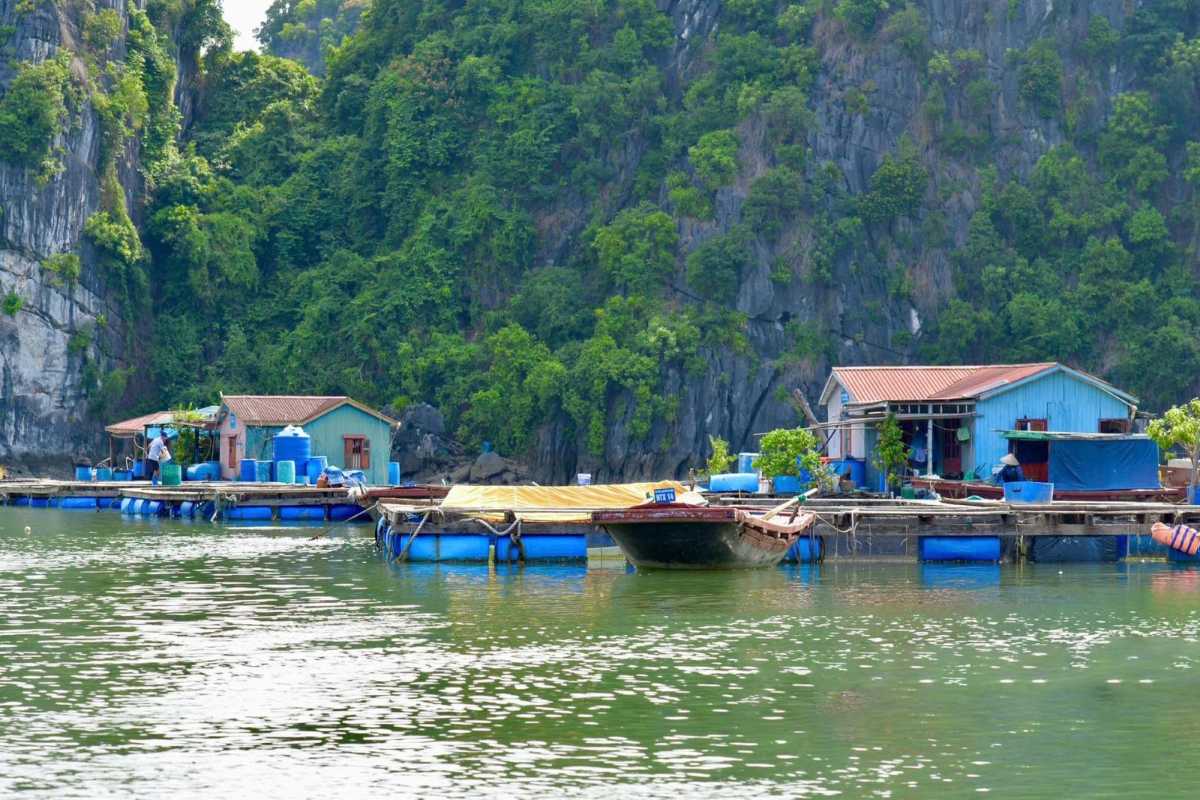
Essential Phrases for Connecting with Locals
Visiting Vung Vieng Fishing Village becomes even more rewarding when you connect with the local community. Knowing some Vietnamese phrases for travelers can open doors to genuine interactions and show respect for the culture. Here are practical phrases tailored for your visit, along with pronunciation tips and context.
Greetings
- Hello: Xin chào (sin chow) – Use this when meeting locals
- Goodbye: Tạm biệt (tam byet) – When parting ways
- Thank you: Cảm ơn (gahm un) – Express gratitude
Basic Questions
- How much?: Bao nhiêu? (bow new) – Asking prices politely
- Where is…?: Ở đâu? (uh dow) – To ask for directions
Food and Dining
- Delicious: Ngon (ngawn) – Complimenting food
- I’m allergic to…: Tôi bị dị ứng với… (toy bee zee ung voy…) – Important for safety
Respectful Communication
- Please: Làm ơn (lam un) – When making requests
- Excuse me / Sorry: Xin lỗi (sin loy) – For apologies or to get attention
Using these phrases helps you navigate daily interactions smoothly and shows your appreciation for Vietnam’s rich culture. Remember, a warm smile goes a long way.
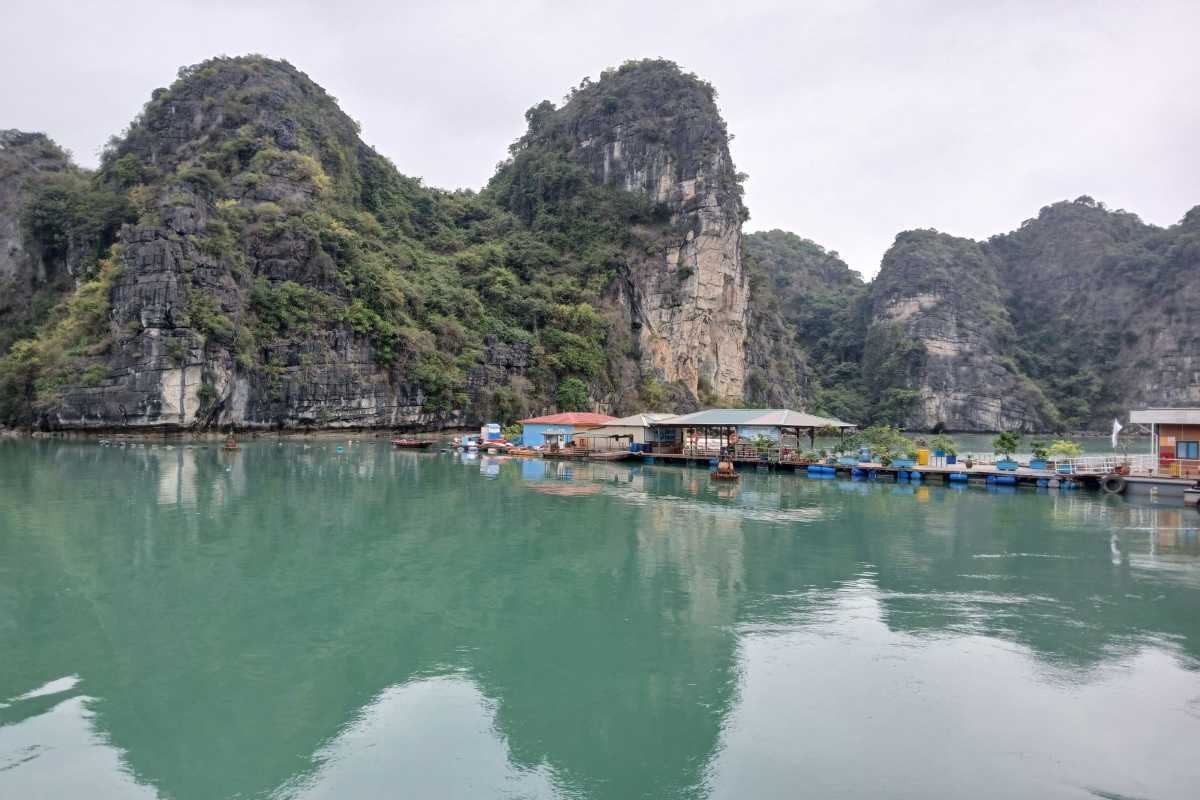
Planning Your Visit to Vung Vieng Fishing Village
Planning your visit to Vung Vieng Fishing Village requires some practical preparation to ensure a smooth and enjoyable experience. This charming village, nestled within Bai Tu Long Bay, offers unique beauty and tranquility, but reaching it involves multiple transport steps. Knowing your options and timing can save you hassle and help maximize your time soaking in the authentic floating village lifestyle.
To begin with, the most common starting point is Hanoi, Vietnam’s capital. From there, travelers can choose between several modes of transport to reach Vung Vieng, often combining land and sea travel. You’ll want to consider convenience, budget, and time when planning your route.
When organizing your itinerary, keep in mind local schedules and availability of boats or cruises that stop at the village. Booking your cruise or boat trip in advance can secure your place and sometimes offer better rates.
Consider your overall trip length and what activities you want to prioritize once at Vung Vieng—this helps in selecting the right tour or transport method. Taking the time to prepare your route and budget in advance will greatly enhance your experience.
Plan your trip carefully with these tips in mind to enjoy a hassle-free visit to Vung Vieng Fishing Village.
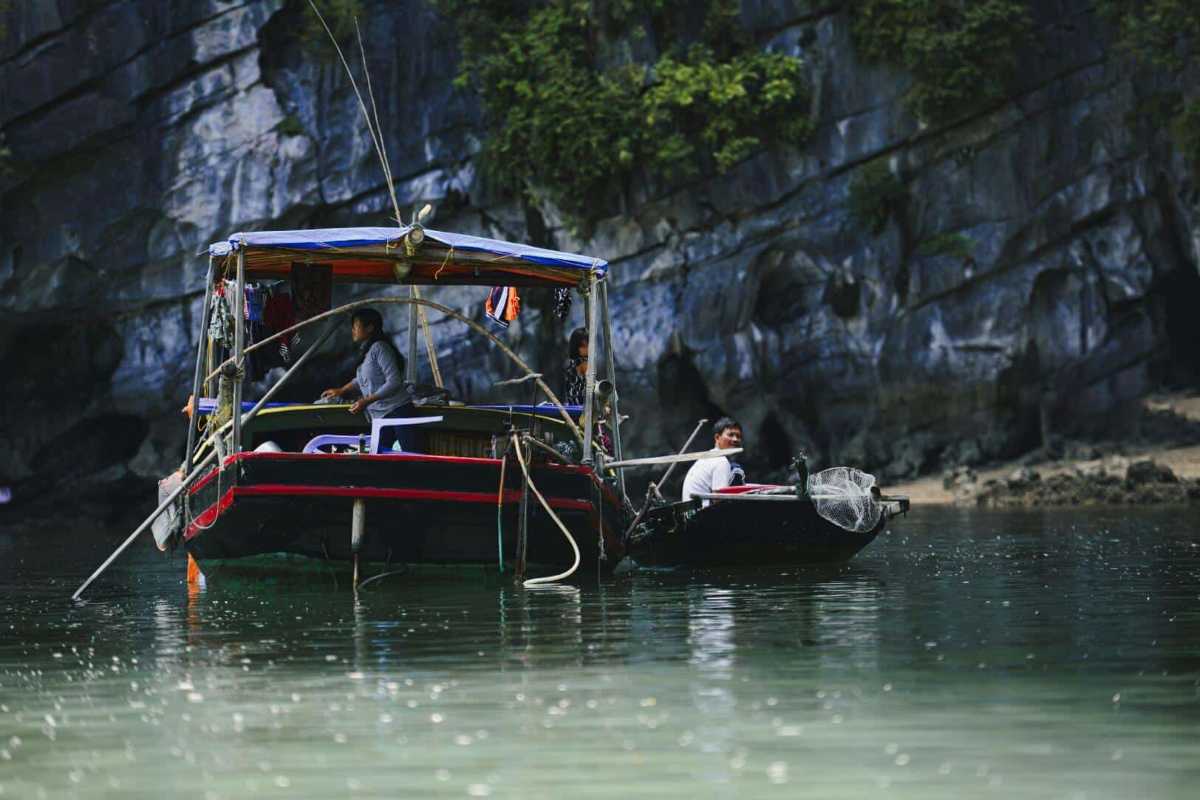
How to Get There: Transportation Options Explained
Traveling to Vung Vieng Fishing Village involves a few stages, typically starting from Hanoi and then moving onward by land and water. Knowing your options helps you pick the best route based on your budget and schedule.
Here are the main transport methods:
- From Hanoi to Halong City or Van Don:
- Train: Offers a scenic route but takes longer; fares are budget-friendly.
- Bus: Frequent services run from Hanoi to Halong City with varied price points.
- Private car or taxi: Offers comfort and flexibility, with higher costs.
- From Halong City or Van Don to Vung Vieng:
- Boat or cruise: Small day-trip boats, traditional wooden sampans, or overnight cruises are popular. Booking ahead is advised.
- Transfers from Van Don International Airport are available via shuttle or taxi to connect with boat trips.
Travel times vary from 3 to 5 hours total depending on your choices, with typical costs ranging from budget-friendly bus fares around $5–$10 to luxury cruises exceeding $150.
Choosing the right combination of transport will depend on your priorities for convenience, comfort, and budget.
From Halong City: Boat and Cruise Transfers
Many visitors begin their journey from Halong City, where various boats and cruises depart to Vung Vieng Fishing Village. These include day trips on small boats, longer overnight cruises, and traditional wooden sampans.
Popular departure points include Tuan Chau and Hon Gai ports. It’s highly recommended to book your boat or cruise early, especially during peak travel seasons, to ensure availability and the best price.
Most boat tours offer scenic routes through Bai Tu Long Bay, providing stunning views of limestone karsts along the way. The boats vary from basic day-trip vessels to luxury cruises with full amenities.
Planning your transfer from Halong City carefully can make your trip more comfortable and enjoyable.
Access via Van Don International Airport and Local Transport
If you fly directly to Van Don International Airport, getting to Vung Vieng Fishing Village is straightforward with several transfer options available.
Shuttle buses run between the airport and nearby harbors, connecting travelers to boat departures. Taxis and private transfers offer more direct and flexible travel but at a higher cost.
From the harbor, boats or cruises will take you through the scenic Bai Tu Long Bay waters to Vung Vieng. Planning your arrival and connecting transport carefully reduces waiting times and stress.

When to Visit: Best Seasons and Weather Tips
The best time to visit Vung Vieng is during the dry season, which lasts from October to April. During these months, the weather is generally sunny and pleasant, with mild temperatures and low humidity. This period offers ideal conditions for exploring the floating village and enjoying outdoor activities like boating and kayaking without interruptions from heavy rain.
The rainy season from May to September brings frequent showers and occasional storms, which may disrupt travel plans and reduce visibility of the stunning natural landscape. However, visiting during the shoulder months of October and April can offer a balance of fewer crowds and decent weather.
Visitors should also consider local festivals and peak tourism periods to avoid overcrowding and higher prices.
Plan your trip during the dry season for the most comfortable experience and vibrant scenery in Bai Tu Long Bay.
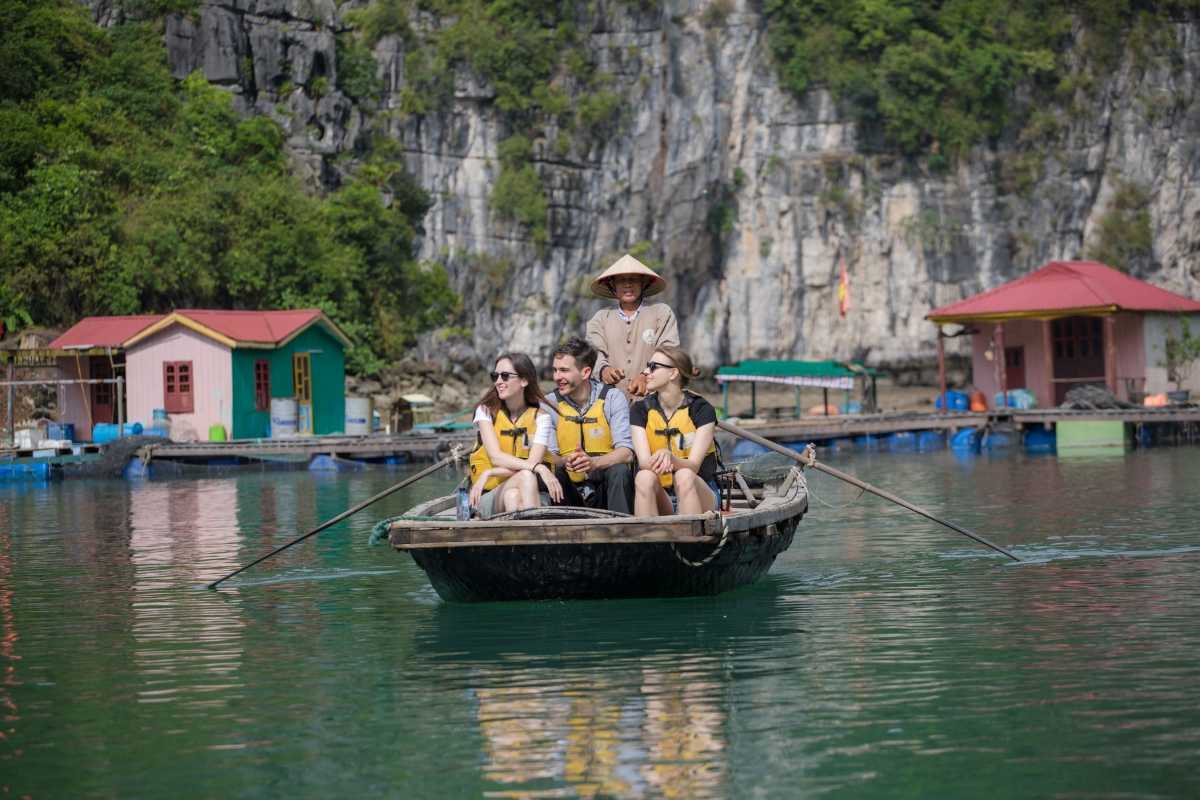
What to Expect on Arrival: Village Layout and Environment
When you arrive at Vung Vieng, you’ll find a charming floating village with a simple, functional layout. The homes and buildings rest on rafts or stilts over the water, connected by narrow walkways and small docks.
Amenities are basic but sufficient, including a few local shops selling essentials and small eateries offering fresh seafood. Electricity and running water are limited in some areas, so expect a rustic, authentic environment rather than modern comforts.
The village atmosphere is peaceful and close-knit, offering an intimate glimpse into traditional Vietnamese fishing life. It’s important to manage expectations regarding infrastructure to fully appreciate the genuine experience.
Knowing what to expect will help you pack appropriately and prepare for the simplicity and charm of the village life.
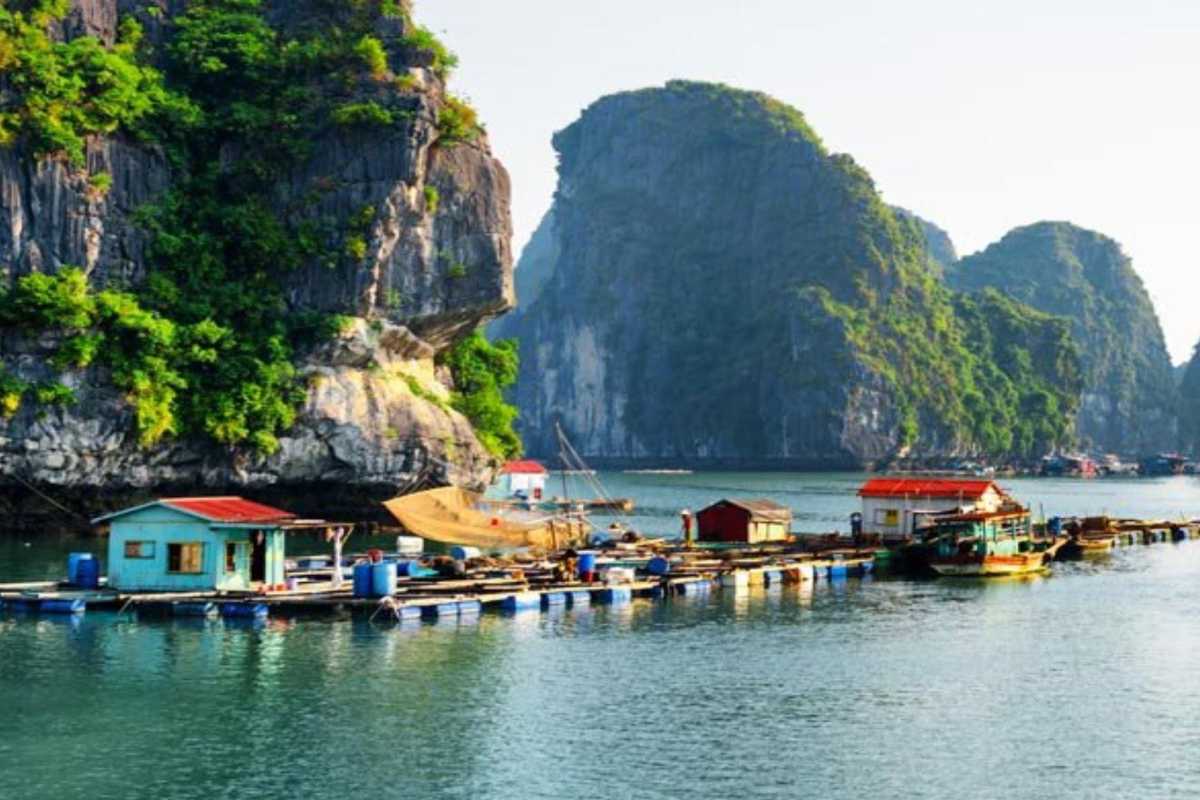
Entry Fees and Tour Costs: What You Need to Know
Visiting Vung Vieng Fishing Village typically involves entry fees for Bai Tu Long Bay, which can range from $10 to $15 per person depending on the season and operator.
Additional costs may include:
- Boat or cruise tours: Day trips generally cost between $40 and $80, while overnight cruises can range from $120 to $250 per person.
- Kayaking rentals: Approximately $10 to $20 per hour.
- Guided activities or fishing experiences: Prices vary but expect around $20 to $40 for specialized tours.
Planning ahead for these expenses will help you budget effectively and avoid surprises during your trip.
Always check with your tour operator for exact pricing and any inclusions to get the best value.
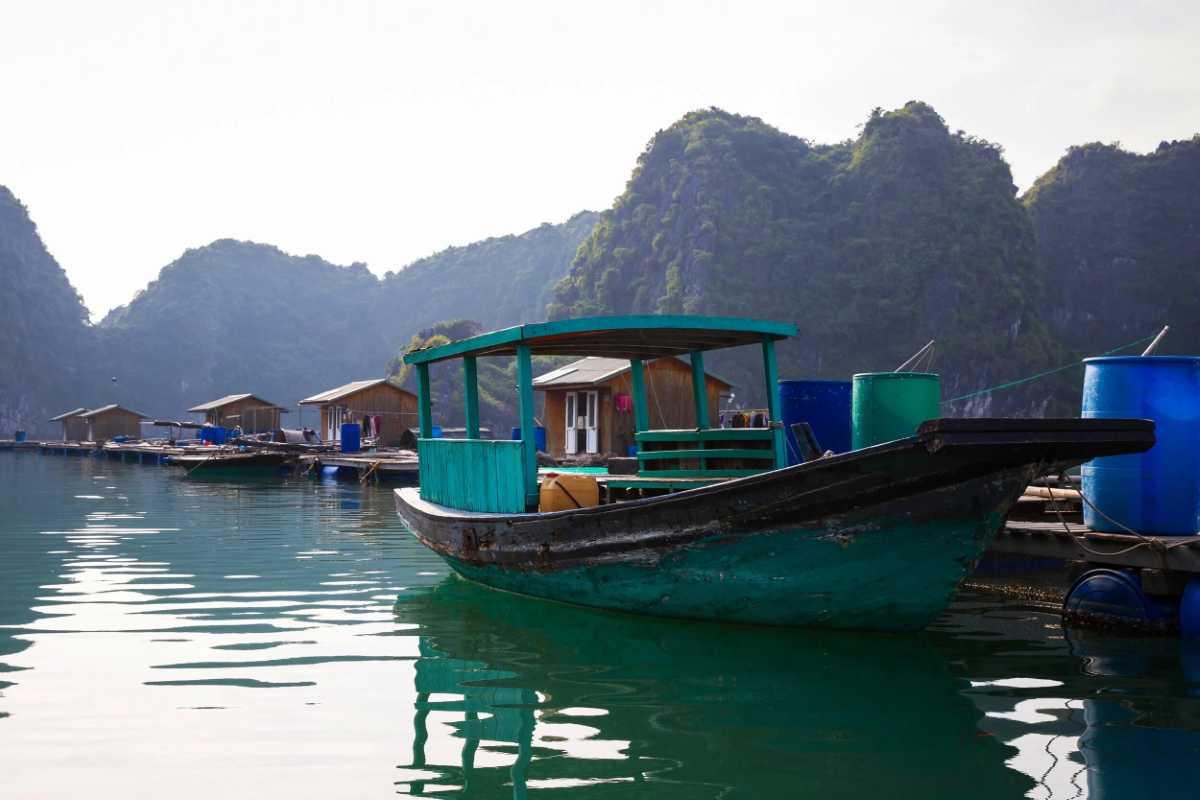
Exploring Activities in and Around Vung Vieng
Discover the many ways to immerse yourself in Vung Vieng activities. The village offers a rich tapestry of authentic experiences that bring you close to the daily rhythms of this floating community. From peaceful boat tours to hands-on fishing, every activity invites you to connect deeply with local culture and stunning nature. Whether you’re seeking relaxation or adventure, things to do in Vung Vieng provide meaningful memories and unique insights.
Plan your visit to include these engaging activities and make the most of your time in Vung Vieng.
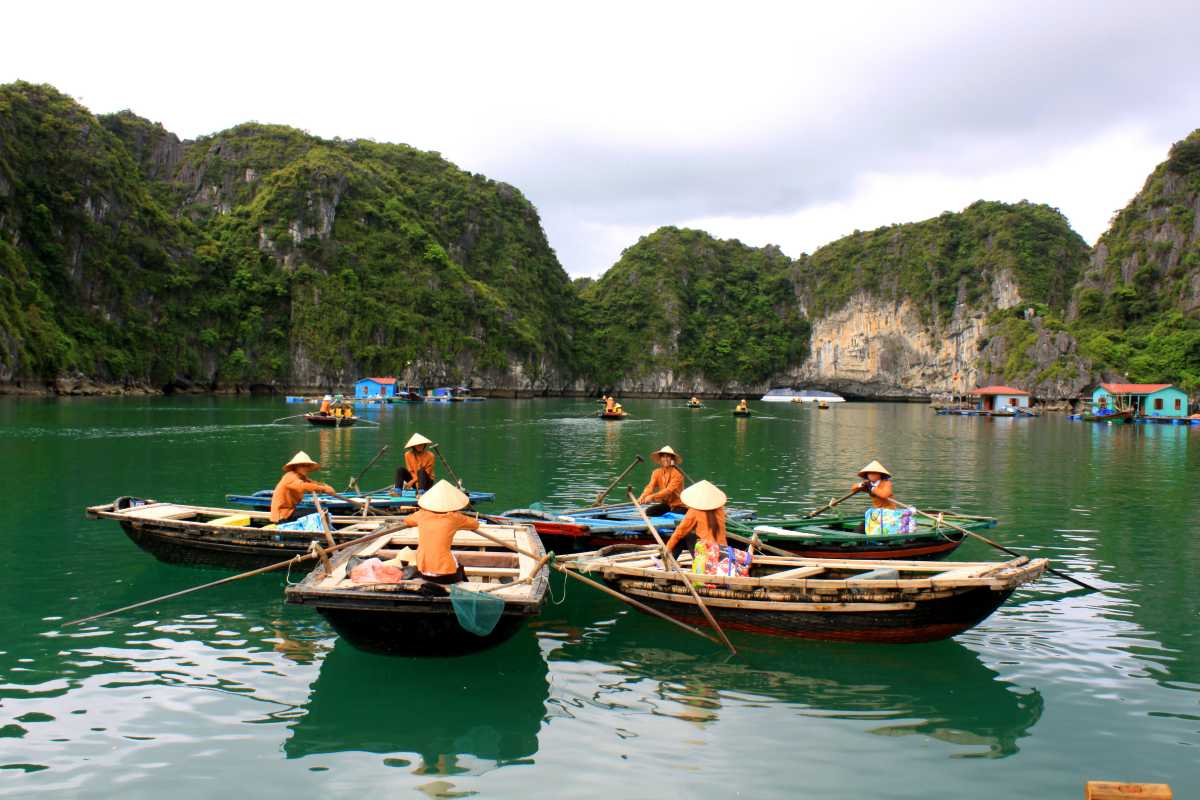
Boat Tours and Scenic Cruises Through the Village
One of the most tranquil ways to experience Vung Vieng is by taking a Vung Vieng boat tour on a small sampan or traditional bamboo boat rowed by local fishermen. This slow, gentle journey offers unparalleled views of the floating village, with its homes and livelihoods intimately connected to the water.
Glide silently past floating houses, colorful fishing nets, and pearl farms, absorbing the peaceful atmosphere that contrasts sharply with more commercialized tourist spots. The boat’s rhythmic oars and the soft splash of water create a meditative soundtrack to your scenic voyage.
Choosing a sampan ride in Vung Vieng allows you to witness authentic village life from a unique vantage point, perfect for photography and reflection. Local guides often share stories, enriching the experience with cultural insights.
Embrace this serene adventure to truly appreciate the calm beauty and heritage of Vung Vieng.
Anya's Take on the Basket Boat: A Serene Journey Through Vung Vieng
The moment I settled into the woven embrace of the small bamboo basket boat, it felt like the world outside the gentle lapping of water against its sides simply ceased to exist. After the slight bustle of transferring from our main cruise ship, this intimate vessel, guided by a softly smiling local woman, offered a perspective of Vung Vieng I hadn't anticipated. It wasn't just a tour; it was a silent glide into the very heart of this floating community, a journey underscored by the rhythmic shush of the oars slicing through the still water.
The air hung thick with a salty-sweet tang, a blend of the sea and the subtle fragrance of what seemed like drying fish nets draped over some of the nearby homes. Sunlight, filtered through the hazy morning air, danced in shimmering patterns on the water’s surface, reflecting the vibrant blues and greens of the floating houses and the towering, craggy limestone karsts that framed the village like ancient sentinels. The gentle rocking of the basket boat was incredibly soothing, a hypnotic rhythm that immediately eased any lingering travel tension. It was a stark contrast to the hum of the larger cruise ship, replaced by the quiet murmur of conversations drifting from the doorways of homes and the occasional splash of a child playing near the water’s edge.
Our rower, a woman with kind eyes and hands that spoke of a life spent on the water, didn't offer a formal narration. Instead, her storytelling was in the way she navigated the narrow waterways, pointing out details with a nod or a brief, gentle word in Vietnamese. She showed us how families had ingeniously created small floating gardens, bursts of green against the predominantly wooden structures. She maneuvered us close to where fishermen were mending their nets, their weathered faces focused on their intricate task. There was a profound respect in her approach, a sense that we were privileged guests, not intrusive onlookers.
One unexpected observation was the incredible resourcefulness of the villagers. Everything had its place and purpose in their compact floating world. I noticed ingenious systems for collecting rainwater, small potted plants adding splashes of color to their verandas, and the quiet efficiency with which daily life unfolded on these buoyant homes. It wasn't a picture of hardship, but one of adaptation and a deep connection to their environment. There was a sense of community, too – neighbors calling out to each other across the water, children paddling smaller versions of these basket boats with confident strokes.
A particularly memorable moment was when our rower paused near a pearl farm. The water here seemed to glow with an almost ethereal quality. She pointed to the submerged oyster cages and, with a few basic English words and gestures, conveyed the delicate and time-intensive process of pearl cultivation. It added another layer of understanding to the resilience and ingenuity of this community, their ability to thrive in harmony with the bay.
Here are some sensory details and practical tips from my serene basket boat journey:
- Listen to the Quiet: The absence of loud engine noise allows you to truly appreciate the subtle sounds of the village – the lapping water, distant conversations, the calls of birds.
- Feel the Gentle Rocking: Allow yourself to relax into the rhythm of the boat. It's surprisingly calming and offers a unique perspective.
- Observe the Reflections: The still waters often create stunning mirror images of the homes and karsts. Keep your camera ready for these picturesque moments.
- Dress Comfortably: Wear light clothing and a hat, as you'll be exposed to the elements.
- Be Mindful of Your Guide: They are often local residents. Show respect through your demeanor and a small tip at the end is a thoughtful gesture.
- Don't Be Afraid to Ask (Gently): While your rower might not be a formal guide, a polite smile and a simple question (if you share a common language or have a translator) can lead to fascinating insights.
My time in the basket boat wasn't about ticking off a tourist activity; it was a deeply immersive experience that allowed me to witness the gentle rhythm of life in Vung Vieng from a truly unique vantage point. It fostered a sense of peaceful connection, a feeling of having been a quiet observer in a world both ancient and enduring.
Recommendation: If you visit Vung Vieng, prioritize the intimate experience of a basket boat ride. It offers a serene and personal perspective of the village that the larger cruise ships simply cannot replicate. It's an opportunity to truly connect with the spirit of this remarkable floating community.
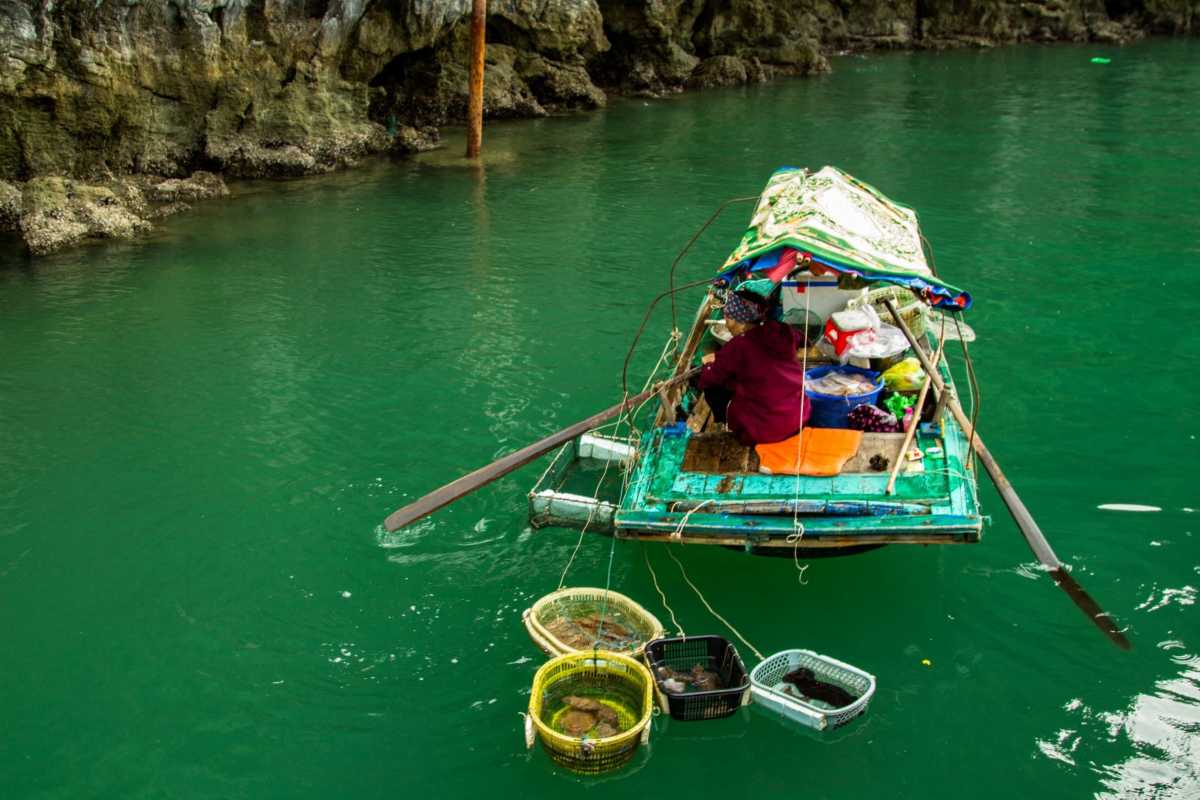
Kayaking Adventures Among Limestone Caves
Exploring Vung Vieng by kayak is an unforgettable way to experience the natural beauty of the area. Paddle through the limestone grottoes and winding waterways that weave between the towering karsts of Bai Tu Long Bay. Kayaking here lets you get up close to the stunning landscape at your own pace, offering moments of solitude and discovery.
Before you set out, be sure to follow essential safety tips to enjoy your adventure confidently. Kayak rentals are available nearby, and many operators provide guided tours or self-guided options depending on your comfort level.
Key safety and practical tips include:
- Wear a life jacket at all times: Safety should be your priority while navigating these waters.
- Choose calm weather days: Avoid kayaking during strong winds or rainy seasons.
- Rent from reputable providers: Ensure the kayaks and gear are well-maintained.
- Plan your route: Familiarize yourself with the caves and landmarks to avoid getting lost.
- Carry essentials: Water, sunscreen, and a waterproof bag for valuables.
Whether you’re a seasoned paddler or trying kayaking for the first time, this activity offers a thrilling way to immerse yourself in Vung Vieng’s unique environment.
Robert's Paddling Prowess: Conquering the Vung Vieng Grottoes by Kayak
After a peaceful morning absorbing the tranquil rhythm of Vung Vieng from a bamboo sampan, it was time to unleash my inner adventurer. Kayaking through the grottoes and around the towering karsts was something I had eagerly anticipated, a chance to truly "conquer" the landscape with my own paddle strokes. This wasn't just about getting from point A to point B; it was about feeling the burn in my shoulders, navigating the hidden passages, and getting up close and personal with the raw, majestic beauty of Bai Tu Long Bay.
The kayaks, brightly colored and surprisingly stable, were lined up near our cruise's tender boat, bobbing gently on the calm water. The sun was climbing, painting streaks of brilliant gold across the emerald surface. As I pushed off, the initial physical effort was immediately noticeable – a satisfying resistance against the water as I found my rhythm. The air was warm and humid, carrying the faint, earthy scent of the limestone and the fresh, briny smell of the sea. The feeling of independence was exhilarating; suddenly, I was the master of my own miniature vessel, free to explore at my own pace.
Our guide, a nimble young man from the village, led us towards a narrow opening in a colossal limestone cliff. My heart thumped with a mix of excitement and a touch of apprehension. Would I fit? Would it be dark inside? The passage was indeed tight, requiring precise paddle strokes and a low duck of the head to clear the ancient rock ceiling. The water, a deeper jade here, reflected the intricate patterns of the stalactites above, creating an almost otherworldly glow. The sounds of our paddles echoed softly, amplifying the profound silence of the grotto, broken only by the drip of water. It was a thrilling challenge, a brief moment of intense focus that made breaking out into the hidden, open-air lagoon on the other side feel like a true discovery. The lagoon was a serene amphitheater of nature, completely enclosed by high cliffs, teeming with vibrant green foliage clinging precariously to the rock faces. Here, I spotted small, colorful fish darting beneath my kayak and heard the chirping of unseen birds high above.
One unexpected challenge was simply remembering to look up. It's easy to get absorbed in the paddling, but the true magic of these grottoes is often overhead. I also found that navigating with others in a small group required a bit of coordinated effort to avoid collisions, adding a lighthearted, communal aspect to the adventure. There was a moment when a light breeze picked up, creating a ripple effect across the water, making the reflections shimmer and distort, transforming the familiar karsts into abstract art. It was a simple, yet profoundly awe-inspiring moment.
The triumph wasn't just in reaching the hidden lagoons; it was in the physical engagement, the intimate connection with the environment, and the sense of accomplishment. It’s an adventure that awakens the senses and reminds you of the incredible power and artistry of nature.
Here are some practical tips I learned from my kayaking expedition in Vung Vieng:
- Best Time to Go: Early morning or late afternoon. The light is softer for photography, the heat is less intense, and the waters are often calmer. Avoid midday if possible.
- What to Wear: Light, quick-drying clothing (swim shorts, t-shirt or rash guard), and water shoes or sandals that can get wet. Sun protection is crucial: a wide-brimmed hat, sunglasses, and high-SPF sunscreen are a must.
- Bring a Dry Bag: Absolutely essential for your phone, camera, and any other valuables you want to keep dry. Water will get into your kayak!
- Listen to Your Guide: Always follow their instructions, especially when entering and exiting grottoes or navigating narrow passages. They know the tides and currents.
- Stay Hydrated: Even on cloudy days, paddling is physical work. Bring a water bottle.
- Paddle at Your Own Pace: It's not a race. Take your time, soak in the views, and allow yourself moments of quiet awe.
- Look Up and Around: Don't just focus on the water. The limestone formations, the vegetation, and even small cave openings are part of the incredible experience.
Recommendation: If you're physically able and looking for an immersive way to experience the hidden wonders of Bai Tu Long Bay, kayaking in Vung Vieng is an absolute must. It's an invigorating and awe-inspiring adventure that brings you closer to nature and the unique geology of this incredible place.

Hands-On Fishing Experiences with Locals
Engage deeply with the heart of Vung Vieng by joining local fishermen in their daily routines. This Vung Vieng fishing experience offers more than just a chance to catch fish—it’s an authentic cultural exchange where you learn traditional techniques passed down through generations. Villagers welcome curious travelers to try their hand at net casting, crab trapping, and other time-honored methods unique to Bai Tu Long Bay.
This immersive activity allows you to connect with the rhythms of local life and gain respect for the enduring fishing traditions that sustain this community. It’s a rare opportunity to witness the delicate balance between nature and livelihood while building meaningful interactions with residents.
Elena's Net Gain: My First Time Fishing with a Vung Vieng Local
I've always been intrigued by the idea of living off the land, or in Vung Vieng's case, off the water. So, when the opportunity arose to try traditional fishing with a local, I leaped at it. This wasn't just about catching fish; it was about stepping into someone else's daily rhythm, attempting to understand a way of life intrinsically tied to the bay. What I discovered was a profound lesson in patience, respect, and the quiet dignity of a timeless craft.
The sun was high when our small group motored towards a fishing boat where Mr. Hai, a man whose smile crinkled the corners of his eyes, waited patiently. The air was still, warm, and carried the ubiquitous scent of salt and sun-dried wood. He greeted us with a welcoming gesture, and I climbed onto his surprisingly sturdy wooden boat. The planks felt smooth beneath my feet, worn by years of use. Mr. Hai spoke limited English, but his gestures and genial demeanor communicated volumes. He immediately began demonstrating the casting net technique, a fluid, almost dance-like motion that sent the net spiraling gracefully through the air before hitting the water with a soft plop. It looked deceptively easy.
My turn. He handed me a net, heavier and more cumbersome than I expected. The rough twine felt alien in my hands. Mr. Hai patiently guided my stance, adjusting my grip, and showing me the intricate way to hold the net's weighted edges. My first few attempts were, to put it mildly, pathetic. The net either flopped into a messy heap or sailed barely a foot from the boat, eliciting gentle chuckles from Mr. Hai and my fellow travelers. There was a moment of fleeting frustration, but it quickly dissolved into amused determination. I realized this wasn't about instant success; it was about the attempt, the connection, the shared laughter. The patience Mr. Hai exhibited was remarkable, never once showing exasperation, always encouraging with a nod and another demonstration.
The thrill of a potential catch, however, was constant. Each time I cast, a small surge of hope went through me. And then, finally, it happened. On my seventh or eighth try, the net actually opened. It wasn't perfect, but it was enough. As I pulled it in, there was a weight, a faint struggle. My heart pounded! And there, shimmering in the mesh, were two small, silvery fish. They weren't huge, but to me, they were trophies. Mr. Hai beamed, giving me an enthusiastic thumbs-up. It was a shared moment of success, a tiny victory that transcended language barriers.
Through this simple act, I learned so much about their way of life. It’s not about grand catches every time; it’s about persistence, adapting to what the bay offers, and respecting its bounty. I observed how Mr. Hai cared for his nets, how he scanned the water with an intuitive knowledge, and how he simply belonged to this environment. The interaction, though minimal in words, was rich in shared experience and quiet understanding. It highlighted the beauty of a life lived in harmony with nature's rhythms, far removed from the constant rush of city life.
Here are some practical takeaways from my hands-on fishing experience:
- Patience is Key: Don't expect to be a master fisherman instantly. Embrace the learning process and the quiet moments between casts.
- Dress Appropriately: Wear comfortable, quick-drying clothes that you don't mind getting a little wet or fishy. Sunscreen and a hat are essential.
- Open Mind, Open Heart: Be ready for a genuine cultural exchange, not just a demonstration. Engage with your local guide, even if language is a barrier – smiles and gestures go a long way.
- Respect the Craft: Observe how the locals handle the fish and their equipment. It's a livelihood passed down through generations.
- Tip Graciously: If it's not explicitly part of your tour fee, offer a small tip to your local guide as a thank you for their time and patience.
My net "gain" wasn't just those two small fish; it was a profound appreciation for the resilience and expertise of the Vung Vieng fishing community. This experience offered a truly authentic slice of their daily lives, leaving me with a deeper respect for their traditions and an unforgettable connection to the bay.
Recommendation: If you're looking to dive deeper than just sightseeing and truly connect with the heart of Vung Vieng, I highly recommend seeking out a traditional fishing experience with a local. It's an immersive, rewarding activity that offers unique insights into their way of life and creates lasting memories.
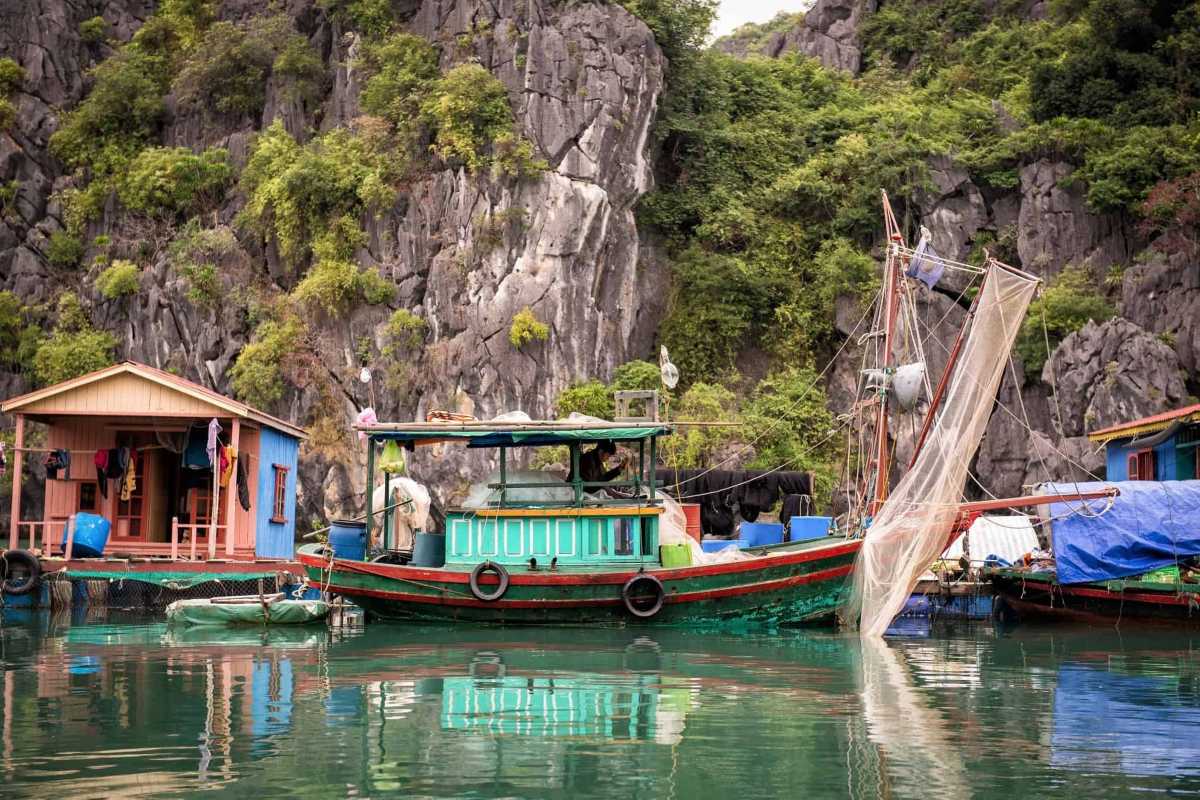
Visiting Pearl Farms: A Unique Insight
A visit to a Vung Vieng pearl farm tour offers an educational glimpse into a vital part of the village’s economy and culture. You’ll learn about the delicate process of pearl cultivation, starting from oyster farming to the harvesting of precious pearls. These farms are not only economic hubs but also custodians of traditional techniques refined over generations in Bai Tu Long Bay. Visitors often have the unique opportunity to purchase pearls directly, supporting local families and ensuring authenticity.
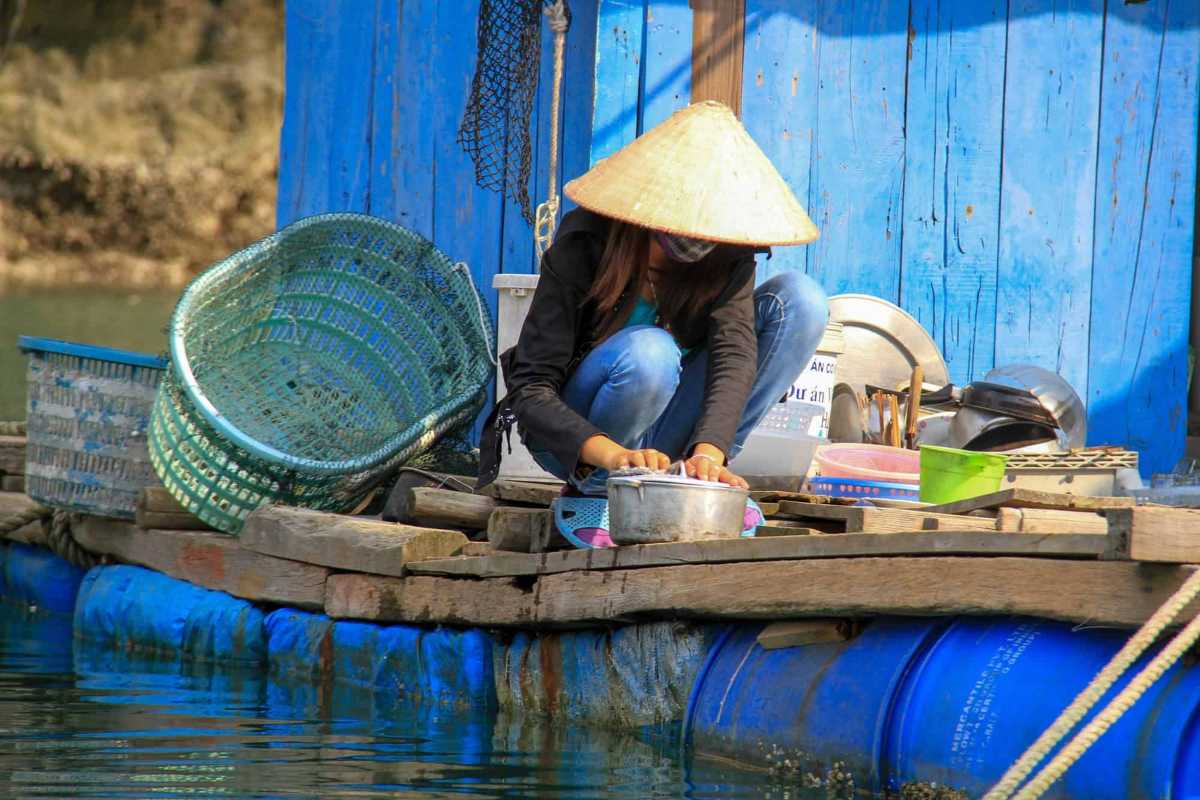
Homestays and Cultural Exchanges
Staying in a Vung Vieng homestay offers an intimate way to experience local life firsthand. Often promoted by ethical tour operators, these homestays invite you into the daily rhythm of the floating village, where cultural exchanges go beyond sightseeing. Sharing meals, stories, and traditions with your host family creates deep connections and lasting memories, offering more than just accommodation—it’s an immersive cultural experience in Bai Tu Long Bay.
How to Book and What to Expect
Booking a Vung Vieng homestay usually involves working with trusted tour operators who specialize in authentic experiences in Vung Vieng. It is best to research and contact operators who prioritize ethical tourism and offer clear details about accommodation and activities. Booking early is advisable, especially during peak travel seasons, to secure your preferred dates.
- Finding a reputable tour operator: Look for positive reviews and transparent communication.
- Booking in advance: Ensure availability during busy periods.
- Confirming payment terms and cancellation policies: Avoid surprises by understanding conditions clearly.
What to Expect during your homestay stay includes embracing rustic but welcoming living conditions. Facilities are basic, often with simple bedding, limited electricity, and shared bathrooms. Your hosts will provide warm hospitality, sharing their daily lives and traditions. Expect to engage in meaningful cultural exchange, including shared meals and participating in local routines. The pace is slow and immersive, perfect for travelers seeking authentic connections over luxury.
- Basic accommodation: Simple furnishings and modest amenities reflecting village life.
- Genuine local interaction: Opportunities for cultural exchange with host families.
- Limited modern conveniences: Be prepared for minimal electricity and basic facilities.
- Quiet and peaceful atmosphere: Ideal for relaxation and immersion.
These insights will help you prepare practically and mentally, making your Vung Vieng homestay both comfortable and memorable.
Chloe's Candid Homestay: Life on the Water in Vung Vieng
Stepping onto the rickety wooden planks of the homestay in Vung Vieng, I felt a nervous thrill. Most visitors to Bai Tu Long Bay experience the floating villages from a distance, perhaps a brief kayak or a bamboo boat ride. But I wanted more. I wanted to understand what it truly meant to live on the water, day in and day out, anchored to a community that calls the bay home. My homestay wasn't a luxury resort; it was a simple, vibrant floating house, and for 24 hours, it became my window into a life beautifully unlike my own. This wasn't just a place to sleep; it was an invitation into the heart of a Vung Vieng family, offering insights far richer than any guidebook.
The initial moments were a whirlwind of new sensations. The gentle, almost imperceptible sway of the house, the constant lapping of water against the pontoons, and the surprisingly spacious interior, despite its humble appearance. My host, Mrs. Linh, a woman with a perpetually warm smile and eyes that sparkled with humor, immediately made me feel at ease, despite our significant language barrier. The air inside had a faint, comforting scent of cooking spices and the clean smell of the open water. Outside, the sounds of the village were a constant, soothing hum: children's laughter echoing across the water, the distant putter of a small boat, and the rhythmic clinking of fishing gear.
Life on the water unfolded with a natural rhythm. My mornings started early, not with an alarm, but with the soft sounds of Mrs. Linh preparing breakfast – usually fragrant rice porridge or fresh seafood noodles. We'd share meals, sitting on low stools around a simple table, the food always incredibly fresh, often caught by her husband that very morning. Though conversation was limited to gestures and shared smiles, the act of breaking bread together fostered an immediate sense of connection. I’d watch them go about their daily routines: mending nets, cleaning their small boat, tending to their floating fish cages. There were challenges, of course; the limited freshwater supply meant short, efficient showers, and adjusting to the constant, subtle movement of the house took a few hours. Electricity was primarily from solar panels, meaning evenings were lit by soft bulbs, encouraging early nights and quiet contemplation under a blanket of stars.
The unexpected joys were countless. Watching the sunset paint the karsts in fiery hues from their floating veranda, feeling the gentle breeze carry the fresh sea air, or simply observing the intricate dance of boats as villagers visited each other. One afternoon, Mrs. Linh's granddaughter, a shy but curious girl named Hoa, showed me how to make a small paper boat, her giggles infectious. Later, her father, Mr. Phong, took me out on his small boat to check his fish traps, patiently demonstrating the process. Despite the language barrier, their hospitality was boundless, communicated through their smiles, shared food, and generous gestures. I truly felt like a temporary member of their family, not just a guest.
This experience brought Vung Vieng to life in a way I couldn't have imagined. It highlighted the resilience, resourcefulness, and deep community spirit of the floating village residents. It wasn't about luxurious comfort, but about rich, authentic cultural immersion.
Here are my practical takeaways if you're considering a Vung Vieng homestay:
- Set Realistic Expectations: Homestays offer basic, authentic accommodations. Don't expect hotel amenities. Embrace the simplicity and the unique experience.
- Embrace the Language Barrier: Don't let limited shared language deter you. Smiles, gestures, and a genuine willingness to learn a few Vietnamese phrases will open doors to incredible interactions.
- Be Respectful and Observant: You are entering someone's home and way of life. Be mindful of their routines, traditions, and privacy. Observe before acting.
- Bring Small Gifts (Optional but Appreciated): Simple gifts from your home country (e.g., small trinkets, postcards, or even local snacks) can be a lovely gesture of appreciation, especially for children.
- Pack Light and Smart: A small backpack with essentials is best. Quick-dry clothing, sun protection, and a waterproof bag for electronics are vital.
- Be Open to Participation: If offered, participate in daily activities like preparing a meal or helping with a chore. This is where true connection happens.
My homestay in Vung Vieng wasn't just a place to sleep; it was a profound lesson in humanity, connection, and the beauty of a life lived harmoniously with nature. It solidified my belief that the most authentic travel experiences are often found far from the beaten path, in the quiet generosity of local communities.
Recommendation: For the truly adventurous traveler seeking an unparalleled level of immersion and authentic cultural exchange, a homestay in Vung Vieng Fishing Village is an absolute must. It’s a privilege to be welcomed into this unique community, and an experience that promises to be one of the most rewarding of your entire trip to Vietnam.
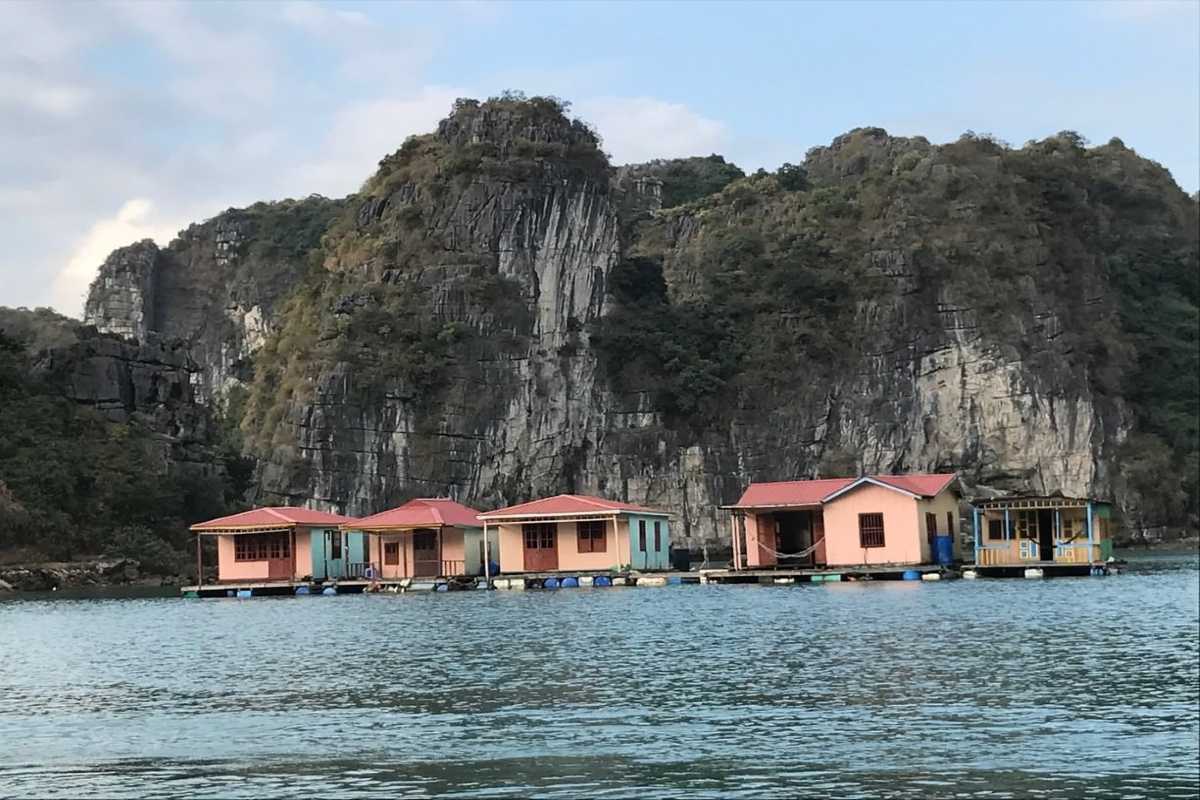
Photography Hotspots and Nature Watching
Vung Vieng photography spots offer breathtaking views, especially during sunrise and sunset when the light casts a golden glow over the limestone karsts. The calm waters reflect the dramatic formations, creating perfect conditions for stunning photos. Key locations include the village's edge overlooking the bay, quiet inlets surrounded by towering karsts, and floating platforms used by fishermen. Early mornings and late afternoons are ideal times for capturing the unique atmosphere.
Nature watching is equally rewarding here. The rich marine wildlife and bird species, including kingfishers and herons, add life to the scenery. Visitors are encouraged to observe respectfully, minimizing disturbance to the environment. Practicing responsible eco-tourism helps preserve the delicate balance of this ecosystem.
- Sunrise and sunset views: Best times for soft light and colorful skies.
- Limestone karsts backdrops: Iconic geological formations for dramatic photos.
- Floating village perspectives: Capture daily life and traditional boats.
- Birdwatching spots: Quiet areas to spot native bird species.
- Marine life observation: Snorkeling or boat trips reveal diverse aquatic creatures.
Planning your visit around these moments ensures you enjoy both the visual beauty and the peaceful natural environment of Vung Vieng and Bai Tu Long Bay.
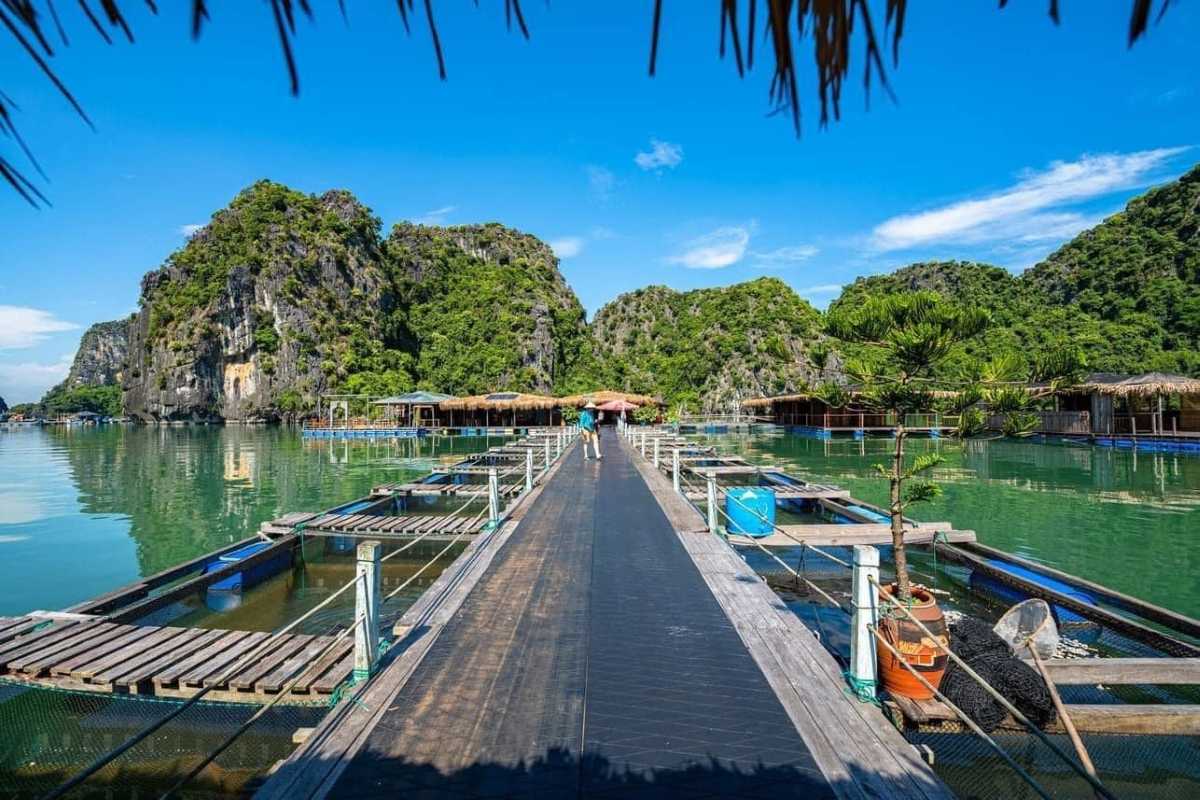
Immersive Vung Vieng Experiences: Beyond the Tourist Path
Discover the unique Vung Vieng experiences that take you beyond typical tourist paths. This section invites you to immerse yourself deeply in the sensory richness and cultural vibrancy of Vung Vieng. Experience life as locals do, exploring hidden gems and embracing authentic interactions that reveal the heart of Bai Tu Long Bay.
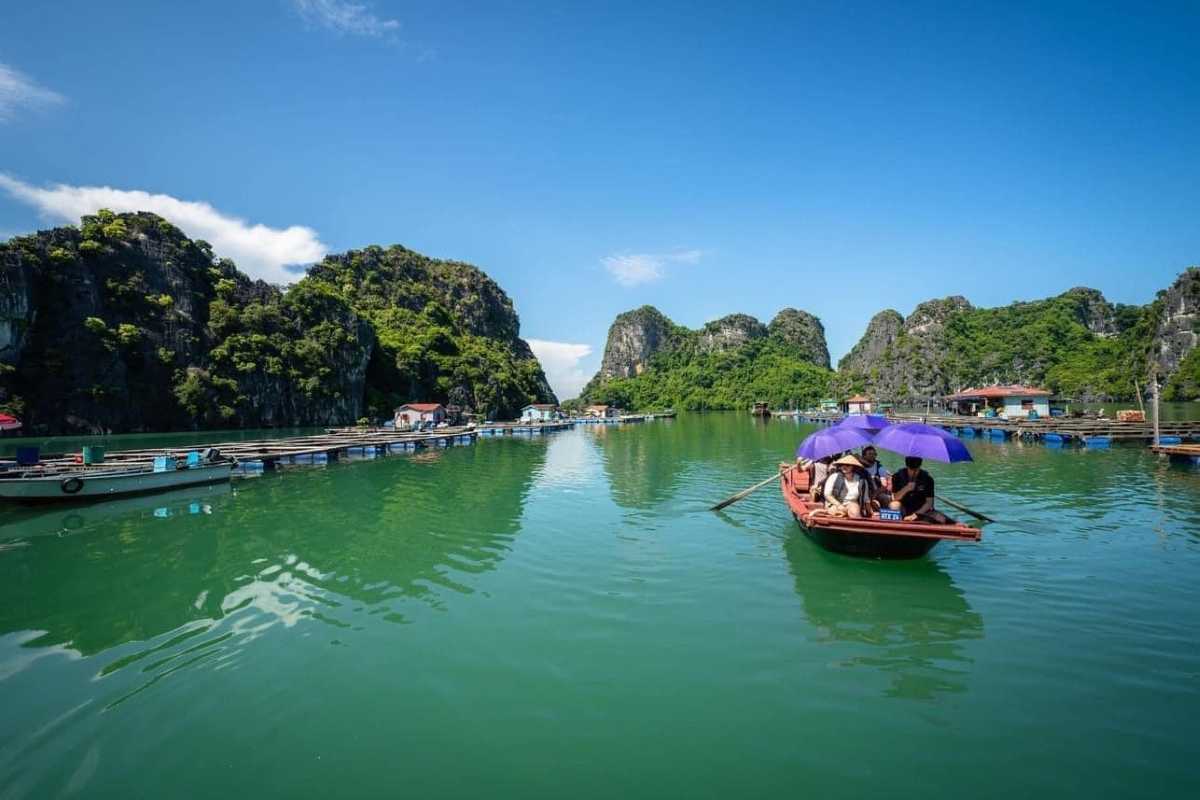
Culinary Delights: What to Eat in Vung Vieng
Fresh seafood is the cornerstone of Vung Vieng local food. Prawns, squid, and a variety of fish are caught daily and prepared using traditional methods passed down through generations. The floating community specializes in simple yet flavorful dishes, often grilled over open flames or cooked in clay pots, preserving the natural tastes of the sea. Unique recipes feature local herbs and spices, offering an authentic taste of Vietnamese floating village cuisine.
Sarah's Spoon: My Unexpected Culinary Journey in Vung Vieng
I've always believed that to truly understand a culture, you must taste it. So, while I anticipated stunning views and authentic interactions in Vung Vieng, I wasn't quite prepared for the culinary revelation that awaited me. This wasn't about fancy restaurants or elaborate menus; it was about the freshest seafood imaginable, prepared with a simplicity that spoke volumes about the villagers' deep connection to their bay. My unexpected culinary journey began with a single spoon, dipping into a bowl of pure, unadulterated flavor, revealing the true essence of eating like a local in Vung Vieng.
The aroma hit me first, even before I saw the dish. It was a tantalizing mix of salty sea air, fragrant herbs, and a subtle smokiness, wafting from the small, open-air kitchen on the floating house where our guide had arranged a special lunch. The sun was high, sparkling on the calm jade water, and the gentle rocking of the boat made me feel truly at one with the environment. My stomach rumbled in anticipation.
Then it arrived: a large, steaming platter of what looked like perfectly grilled prawns and squid, alongside a vibrant green salad tossed with herbs and a bowl of clear, aromatic broth. The prawns, still glistening with sea water, were plump and a beautiful coral pink. Their shells had that satisfying char, hinting at a smoky sweetness. The squid, cut into tender rings, looked impossibly fresh. But it was the broth that truly captivated me. It was clear, almost translucent, with slivers of ginger and spring onion floating within. The fragrance was delicate yet complex, hinting at the deep umami of seafood but without being overwhelming.
I picked up a prawn, its shell still warm. The first bite was a revelation: sweet, firm, and juicy, bursting with the pure taste of the ocean. It was unlike any prawn I'd ever tasted, lacking that "fishy" aftertaste you often find elsewhere. This was just… pure prawn. The squid was equally tender, with a slightly chewy texture and a clean, fresh flavor. But the most surprising ingredient, and the true star for me, was the unassuming bowl of broth. Our guide explained it was made from the heads and shells of the very prawns we were eating, simmered with just a touch of fish sauce, ginger, and green onions. It was the epitome of "no waste," a testament to the villagers' resourcefulness.
I took a spoonful of the broth, letting its warmth spread through me. It was incredibly light, yet packed an intense, savory punch. There was a subtle sweetness, a whisper of the sea, and a comforting earthiness from the ginger. It cleansed the palate, preparing it for the next bite of seafood. It wasn't a "secret" ingredient in the traditional sense, but the preparation – simple, fresh, and respectful of the natural flavors – was the secret itself. This wasn’t just a meal; it was a connection to the bay, to the daily catches, to the sustainable way of life these people embraced. It was authentic, unpretentious, and utterly delicious.
Here are some sensory details and practical tips from my Vung Vieng culinary journey:
- Savor the Aromas: Take a moment to breathe in the scents – the fresh salt air, grilling seafood, and fragrant herbs.
- Taste the Purity: Expect simple preparations that highlight the inherent freshness of the ingredients, particularly the seafood.
- Notice the Texture: Pay attention to the firm, delicate texture of truly fresh seafood.
- Ask About the Broth: Don't overlook the simple broths; they are often the true essence of the meal and a testament to local culinary wisdom.
- Embrace Shared Meals: If you have the opportunity to share a meal with locals (as part of a homestay or organized activity), fully engage. It's not just about the food, but the communal experience.
- Be Open to New Tastes: Even if a dish looks unfamiliar, give it a try. You might discover a new favorite.
My culinary journey in Vung Vieng taught me that the best food experiences are often the simplest, rooted in the freshest ingredients and a deep connection to the environment. It left me with a profound appreciation for the ingenuity and deliciousness of their floating village cuisine.
Recommendation: Don't just admire Vung Vieng from afar; taste it! Seek out opportunities to enjoy a freshly prepared seafood meal, ideally with locals, to truly understand the flavors that define life on Bai Tu Long Bay. It's an essential part of the authentic Vung Vieng experience.
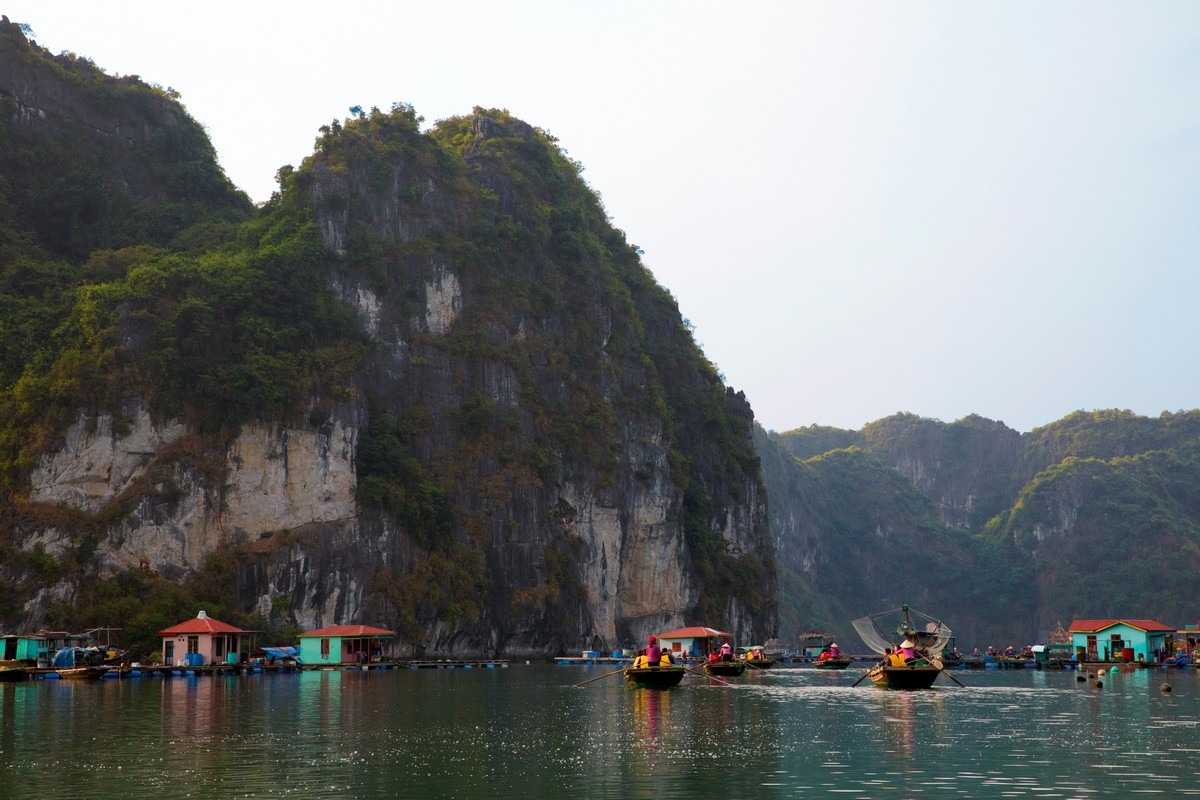
Understanding Vung Vieng's Environmental Conservation Efforts
Preserving the natural beauty of Vung Vieng and Bai Tu Long Bay is essential to maintaining the village’s charm and ecological health. Local initiatives focus on reducing plastic waste, promoting sustainable fishing practices, and protecting the delicate marine ecosystem. Community groups and tour operators are increasingly embracing eco-tourism principles, encouraging visitors to respect the environment. However, challenges remain, including pollution and overfishing risks, which require continued attention and collective responsibility.
Liam's Lens: Witnessing Vung Vieng's Commitment to the Environment
As a photographer and avid traveler, I often find myself drawn to destinations where nature and human life intertwine. In Vung Vieng, however, my lens captured something more profound than just picturesque scenes: it revealed a quiet, yet deeply ingrained commitment to environmental stewardship. This wasn't a PR campaign; it was a daily practice, born of necessity and respect for the very waters that sustain them. It completely reshaped my understanding of "eco-tourism" and challenged me to consider my own impact.
From the moment our smaller transfer boat edged closer to the floating village, I began to notice subtle differences. Unlike some other parts of Halong Bay I'd seen, the water around Vung Vieng seemed remarkably clear. There was none of the scattered plastic I'd sadly witnessed elsewhere. The air, too, felt clean and fresh, free from the exhaust fumes of large, idling ships. My first impression was one of meticulous care.
As I kayaked through the village, my paddle dipping silently into the water, I observed the locals' interaction with their environment. Their floating homes, though simple, were immaculately kept. There were designated areas for waste collection, typically large, enclosed bins that were periodically emptied and transported away from the bay. I saw women meticulously sorting debris that had drifted in, separating plastics from organic matter. This wasn't a grand, organized cleanup; it was simply part of their routine, a testament to their understanding that the health of the bay directly dictated their livelihood. I noticed small, traditional fishing boats with minimal engines, often opting for quiet paddling, further reducing their footprint.
Later, I had a brief, but illuminating conversation with our cruise guide, a young man named Quy, who was originally from a nearby coastal town and deeply admired the Vung Vieng community. He explained that their dependence on the bay for fishing and pearl farming meant that conservation wasn't an abstract concept; it was survival. He pointed out areas where specific types of fishing were restricted to allow fish populations to recover, and how local authorities, in cooperation with the villagers, worked to manage tourism to minimize disruption. Quy emphasized that visitors playing a role in keeping the bay clean was paramount. "Our future is in this water," he told me, gesturing to the expanse around us. "If it is not clean, we have nothing." His words resonated deeply.
I also noticed the ingenious use of natural resources. Many homes had simple rainwater collection systems, a pragmatic approach to freshwater scarcity. Solar panels, though small, were visible on several roofs, powering basic necessities. It was a humble, yet effective model of sustainable living, proving that large-scale infrastructure isn't always necessary for environmental responsibility. This firsthand observation, far more impactful than any documentary, left me with a profound sense of admiration for the Vung Vieng people.
Here are my actionable observations and practical tips on how visitors can contribute to Vung Vieng's environmental commitment:
- Mind Your Waste: This is paramount. Do not litter, even accidentally. Keep all your trash secured and dispose of it properly on your cruise ship or once back on land.
- Use Reusable Bottles: Avoid single-use plastic water bottles. Bring a reusable one and refill it on your cruise.
- Choose Eco-Conscious Tours: Opt for cruise operators and tour companies that explicitly state their commitment to responsible tourism, small group sizes, and local community engagement.
- Minimize Noise: Respect the tranquility of the village. Keep your voice down and avoid loud music, especially when kayaking or on small boats near homes.
- Respect Marine Life: Do not touch or disturb marine life. Observe from a distance.
- Support Local, Sustainable Practices: If you purchase pearls or crafts, ensure they are genuinely local and sourced responsibly. Inquire about the production methods if possible.
- Limit Water Usage (if on homestay): Be mindful of freshwater scarcity if you're lucky enough to experience a homestay.
Witnessing Vung Vieng's authentic dedication to their environment through my own eyes, rather than just reading about it, was a powerful experience. It reinforced that true sustainability comes from a deep-seated connection to place and a collective understanding of interdependence. It truly inspired me to be a more conscious traveler.
Recommendation: As you journey through Vung Vieng, take the time to observe how the locals live in harmony with their environment. Engage respectfully, and most importantly, be a responsible visitor. Your actions, however small, contribute to preserving this incredible floating world for generations to come.

Shopping for Authentic Souvenirs: What to Look For
When visiting Vung Vieng, finding genuine local handicrafts is a rewarding way to support the community and bring home meaningful memories. Look for items such as small woven baskets, handmade textiles, and natural pearls harvested from the village’s pearl farms. Remember to bargain politely and respectfully, keeping in mind the cultural norms. Purchasing directly from local artisans not only ensures authenticity but also contributes to the village’s economy. Always prioritize quality and uniqueness over mass-produced souvenirs.
Maya's Market Finds: My Hunt for the Perfect Vung Vieng Keepsake
As a traveler, I'm not really one for mass-produced trinkets. For me, a souvenir isn't just an object; it's a tangible memory, a story whispered through the hands that crafted it. So, when I arrived in Vung Vieng Fishing Village, I wasn't just looking for something to buy; I was on a quiet hunt for that perfect keepsake, something that truly embodied the unique spirit of life on Bai Tu Long Bay. It wasn't a sprawling market experience, but a handful of precious interactions that led me to my most cherished find.
The "shops" in Vung Vieng are not what you'd typically imagine. They are often just small sections within floating homes, or a simple display on a boat, reflecting the pragmatic, resourceful nature of the community. The air was wonderfully fresh, carrying the clean scent of the bay, occasionally mingled with the aroma of a nearby meal cooking. Sunlight glinted off the water, creating a sparkling, ever-changing backdrop to these impromptu storefronts. I passed by displays of gleaming pearls – a prominent industry here – and hand-woven fishing nets, each knot a testament to skill and patience.
My eyes were drawn to a small, unassuming table outside a floating house, tended by an elderly woman whose face was a roadmap of gentle wrinkles and serene wisdom. On her table were simple, yet exquisitely crafted, woven items made from what looked like dried seagrass or reeds: small mats, delicate baskets, and even tiny, perfectly formed boats. They weren't flashy, but their natural texture and earthy tones spoke of the bay. I picked up a small, round mat, feeling its surprising strength and intricate weave. The texture was slightly rough, yet comforting, reminding me of the natural materials that surrounded the village.
Through our cruise guide, who graciously translated, I learned that the woman, named Ba Cam, had woven these herself. She explained that she collected the reeds from nearby islets, dried them in the sun, and then painstakingly wove them during the quiet hours of the afternoon. This wasn't her primary livelihood, but a cherished craft that kept her hands busy and connected her to the traditions of her ancestors. There was no aggressive sales pitch, just a quiet pride in her work. Her fingers, though aged, moved with an incredible dexterity as she demonstrated a small weaving technique for me. The story behind the mat – the collection of the natural materials, the sun-drying process, the patient hand-weaving by an elderly artisan – made it infinitely more valuable to me than any polished gem.
I purchased the small woven mat. It wasn't expensive, but the exchange felt incredibly rich. It was a tangible piece of Vung Vieng, created by a member of the community, infused with the essence of their life on the water. It wasn't a surprising ingredient or preparation, but the process of acquiring it, the quiet interaction with Ba Cam, and the story she shared, made it the perfect keepsake. It perfectly captures the unpretentious authenticity of Vung Vieng, a reminder of the serene beauty and enduring spirit of its people.
Here are some practical tips for finding your unique keepsake in Vung Vieng:
- Look for Handmade Items: Focus on goods that clearly appear handcrafted. These are more likely to be authentic and directly support local artisans.
- Embrace Simplicity: The charm of Vung Vieng lies in its humble, natural beauty. Your souvenirs will likely reflect this, with items made from natural fibers or materials sourced from the bay.
- Ask About the Story: If possible, ask your guide to translate and inquire about how an item was made, who made it, and what materials were used. This adds immense value to your purchase.
- Be Prepared for Limited Options: Vung Vieng is not a sprawling shopping district. The beauty lies in the few, authentic items you might find. Don't go with a long shopping list.
- Carry Small Denominations (VND): While major cruises might handle transactions, having smaller Vietnamese Dong notes for direct purchases from locals is always helpful and respectful.
- Consider Locally Sourced Pearls: Vung Vieng is known for its pearl farms. While a bigger investment, a pearl directly from the source can be a truly special, authentic souvenir. Ensure you're buying from a reputable, local farm.
- Support Ethically: When you buy directly from a local family or small artisan, you're contributing directly to their livelihood and the sustainability of their community.
My woven mat from Vung Vieng isn't just a decoration; it's a silent storyteller. Every time I see it, I remember the gentle sway of the floating village, the kind smile of Ba Cam, and the profound beauty of a life lived in harmony with the sea.
Recommendation: Don't rush your souvenir shopping in Vung Vieng. Take your time, observe the small displays, and engage with the artisans if possible. The most meaningful keepsakes are often the simple, handmade items that come with a genuine story, offering a tangible link to the authentic charm of this unique floating community.
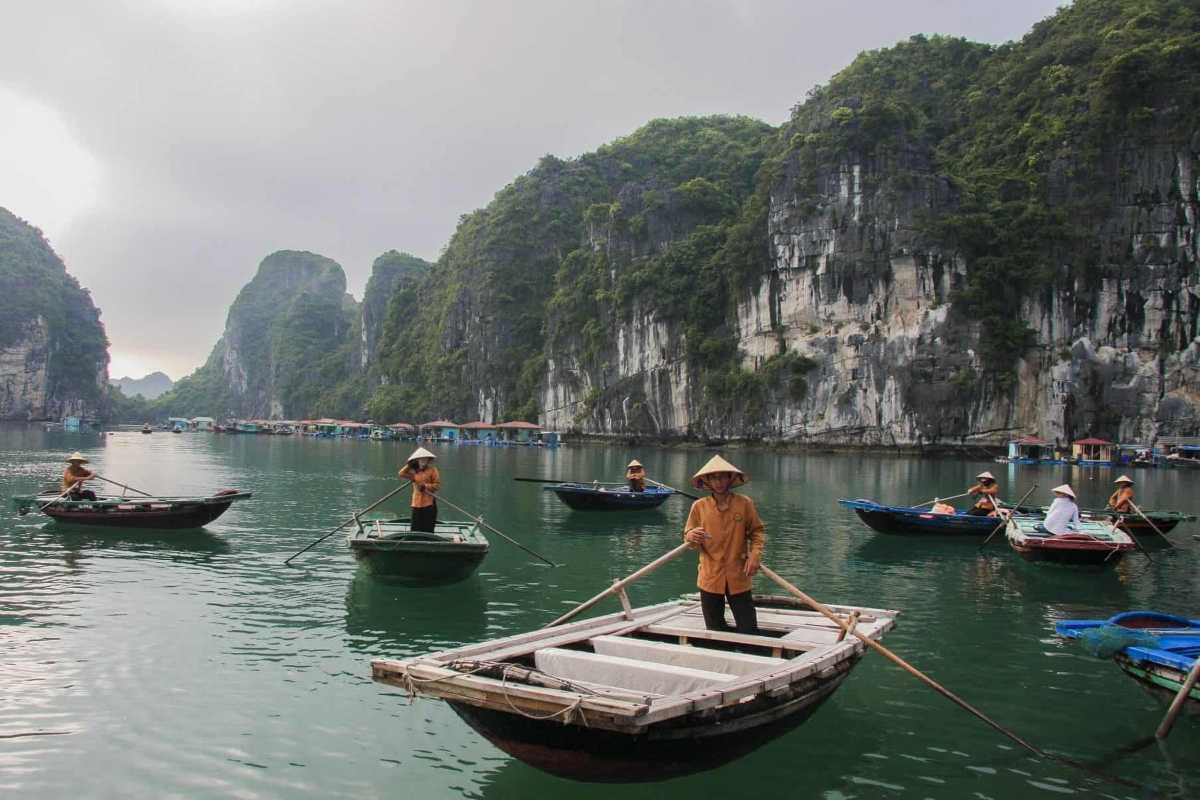
Nearby Attractions and Day Trips from Vung Vieng
When you visit Vung Vieng Fishing Village, consider expanding your itinerary to include other fascinating sights nearby. The region offers a variety of multi-day trips and complementary experiences that let you immerse yourself more deeply in the natural beauty and culture of Bai Tu Long Bay. Exploring beyond the village ensures you make the most of your journey, enjoying everything from tranquil beaches to rugged hiking trails and unique cultural spots.

Exploring Other Floating Villages in Bai Tu Long Bay
Besides Vung Vieng, several other floating villages dot Bai Tu Long Bay, each offering distinct experiences. For example, Cong Dam village is known for its larger community and vibrant market life. Compared to Vung Vieng, which feels more intimate and less commercial, these villages provide travelers with options to explore diverse aspects of floating village culture and lifestyle. Understanding these differences helps you pick the village that best fits your travel preferences.

Bai Tu Long Bay National Park: Hiking and Caves
Bai Tu Long Bay National Park offers exciting opportunities for outdoor enthusiasts. Hiking trails on nearby islands provide panoramic views of the bay’s famous limestone karsts. You can also explore lesser-known caves, many of which are accessible only by kayak or boat. These activities immerse you in the stunning natural environment and offer a peaceful break from more tourist-heavy areas.

Beaches and Islands to Visit Nearby
For those seeking relaxation, several beautiful beaches and islands near Vung Vieng invite swimming, sunbathing, and exploration. Ban Chan Beach, for example, is a peaceful spot perfect for soaking up the sun or enjoying a scenic picnic. Many islands also offer short treks through lush greenery, allowing visitors to discover hidden viewpoints and tranquil nature.

Recommended Multi-Day Tours and Cruises
To fully experience the region, consider booking a multi-day cruise that includes Vung Vieng and other highlights of Bai Tu Long Bay. Options range from 2-day/1-night trips to longer 3-day/2-night journeys. These cruises come in various price points and levels of luxury, catering to diverse budgets and travel styles. Planning your itinerary with one of these tours allows you to relax and explore without worrying about logistics.

Common Concerns & FAQs About Vung Vieng
Visiting Vung Vieng Fishing Village can raise many questions, especially for travelers unfamiliar with floating village life. This section addresses the most common concerns clearly and reassuringly. You’ll find straightforward answers that help you prepare, so your trip is comfortable and enjoyable. Whether you’re traveling with family, worried about accessibility, or need safety tips, this guide offers practical insights to build your confidence in planning.

Is Vung Vieng Suitable for Children/Families?
Many families wonder if Vung Vieng is a safe and enjoyable destination for children. The village offers a safe environment and unique learning experiences that children often find fascinating. Kids can witness traditional fishing, interact with locals, and explore the calm waters. However, be aware that child-specific facilities are limited, and getting on and off small boats may require extra care. Planning ahead and bringing necessary supplies can make the visit smoother and more comfortable for your family.
The Miller Family's Adventures: Vung Vieng Through Our Kids' Eyes
As parents of two energetic, curious kids (Leo, 7, and Mia, 4), "off-the-beaten-path" travel often feels like a risky gamble. Visions of meltdowns, endless "are we there yet?" questions, and safety concerns can quickly deflate any adventurous spirit. But our desire for an authentic, educational experience in Vietnam pushed us towards Vung Vieng Fishing Village. And honestly, seeing Vung Vieng through Leo and Mia's eyes was one of the most rewarding parts of our entire trip, proving that even remote floating villages can be surprisingly family-friendly with a little planning.
Our journey started with a bit of apprehension. The main cruise to Bai Tu Long Bay was comfortable enough, but what would a floating village really be like for young children? Would they be bored? Would it be safe? The moment our smaller transfer boat pulled up to Vung Vieng, all those worries began to dissolve. The kids’ faces lit up. "Look, a floating house!" Mia shrieked, pointing at the colorful structures bobbing gently on the water. Leo, ever the observer, immediately started asking, "How do they get mail? Do they have playgrounds?" Their sheer, unadulterated curiosity was contagious. The air was fresh and salty, the sun warm on our faces, and the gentle lapping of water was a constant, soothing soundtrack.
The highlight for them, hands down, was the bamboo basket boat ride. Initially, Mia was a little hesitant about the round, wobbly boat, clinging to my leg. But our kind local rower, a woman with a gentle smile, quickly put her at ease. She even let Mia dip her fingers in the water! Leo, meanwhile, was enthralled, imagining himself an explorer. The peaceful glide through the village, past other floating homes where children waved from their "windows," felt like something out of a storybook. We pointed out the fish farms, the schoolhouse, and even a floating general store. It was a completely novel experience for them, far more engaging than any land-based museum could have been.
Kayaking was another massive hit for Leo. He's a natural adventurer, and being able to paddle his own (tandem with Dad) kayak through the calm waters and even into some of the smaller grottoes was pure exhilaration for him. Mia was too young to paddle herself, but she enjoyed sitting in the middle seat of our kayak, pointing out fish in the clear water. We ensured we picked a tour with very stable, easy-to-manage kayaks.
Managing practicalities with young ones in such a unique environment did require some foresight:
- Food: Our cruise included all meals, and they were surprisingly accommodating. We stuck to simple, fresh seafood and rice for the kids. Always pack extra snacks – a hungry child is a grumpy traveler, no matter the scenery!
- Naps: The gentle rocking of the boat and the peaceful atmosphere were surprisingly conducive to naps. Mia often drifted off during the quieter parts of the cruise or during the bamboo boat ride, curled up against me. We kept her routine as consistent as possible.
- Safety: This was our biggest concern. The floating nature of the village means water is everywhere. We were vigilant. Life jackets were non-negotiable for both kids whenever we were on any boat or near the edge of our cruise ship. We explained the dangers of the water constantly and held their hands firmly when moving between boats or near floating platforms. The basket boats and kayaks felt very stable, which was reassuring. We also chose a cruise with a secure railing on the deck, providing a safe space for them to move around.
- Entertainment: While the village itself was entertaining, we brought small, lightweight activity books, coloring supplies, and a few favorite small toys for downtime on the boat or during transfers.
Vung Vieng, seen through Leo and Mia's innocent wonder, was transformed from a distant destination into a living, breathing adventure. Their questions, their excitement, and their uninhibited joy in this unique environment made every logistical effort worthwhile. It truly showed us that immersive travel doesn't have to stop once you have kids; it just evolves into something even more magical.
Here are our actionable practical takeaways for families considering Vung Vieng:
- Choose a Family-Friendly Cruise: Look for cruises that explicitly mention kid-friendly activities, stable boats for transfers, and offer life jackets in various sizes. Read family reviews!
- Life Jackets Are Non-Negotiable: Ensure your children wear life jackets at all times when on small boats, kayaks, or near the edge of the cruise ship.
- Pack Smartly for Kids: Bring extra snacks, a reusable water bottle, sunscreen, hats, swimsuits, motion sickness remedies (just in case), and a small first-aid kit.
- Embrace Water Activities: Kayaking (tandem with an adult for younger kids) and bamboo boat rides are typically big hits. They offer safe, contained ways to explore.
- Manage Expectations (Yours & Theirs): It's not a theme park. The entertainment comes from observation, cultural interaction, and the unique environment. Prepare kids for simple facilities.
- Build in Downtime: Long transfers or too many activities can lead to fatigue. Ensure there's time for quiet play or naps.
- Talk to Your Kids: Explain where you're going, what they might see, and the importance of safety. Their understanding will help manage behavior.
Recommendation: For families looking for an authentic, memorable, and surprisingly enriching experience in Vietnam, Vung Vieng Fishing Village is an incredible choice. It's a journey of discovery that offers unique educational opportunities and creates lasting memories for both parents and children, proving that adventure truly knows no age limit.

Accessibility in Vung Vieng: What to Know
Navigating Vung Vieng presents certain challenges for travelers with mobility issues. Getting in and out of boats can be tricky, and the floating homes have narrow walkways and uneven surfaces. There are no formal ramps or disability-friendly facilities available, so it’s important to assess your comfort level carefully. If you have mobility limitations, consider arranging assistance in advance or exploring alternative activities that don’t require extensive boat transfers or climbing. Being aware of these realities will help set realistic expectations and ensure a safer, more enjoyable trip.

Health & Safety Tips for Your Floating Village Visit
Visiting Vung Vieng Fishing Village safely means preparing for sun exposure, hydration needs, and potential sea sickness during boat rides. Carry sunscreen, wear a hat, and bring insect repellent to protect against local bugs. Stay hydrated by drinking plenty of water, and consider seasickness medication if you are prone to motion sickness. Basic first aid supplies can be handy for minor scrapes or bites. Respect personal space while on boats and in the village to maintain a comfortable environment for everyone. Keep emergency contact numbers handy in case of urgent situations.

Practical Tips for a Memorable Visit
Visiting Vung Vieng Fishing Village is a rewarding experience, but being prepared will make your trip smoother and more enjoyable. This travel guide shares essential tips that help you navigate the unique floating village environment respectfully and safely. From packing the right gear to understanding local customs, these practical insights ensure your visit honors the community and environment while maximizing your comfort and enjoyment. Take these recommendations to heart to create lasting memories of your journey to Vung Vieng.

What to Pack for Your Trip
Preparing for a visit to Vung Vieng means packing smartly for the floating village lifestyle and tropical environment. Your packing list should focus on comfort, protection, and practicality for boat rides and outdoor activities. Here’s what to bring for a hassle-free and enjoyable experience.
Packing Essentials:
- Quick-dry clothing: Lightweight and fast-drying fabrics suit boat trips and humid weather.
- Sun protection: Bring sunscreen, a wide-brimmed hat, and sunglasses to guard against strong tropical sun.
- Waterproof bag: Keep valuables safe and dry during boat rides and unexpected splashes.
- Insect repellent: Protect yourself from mosquitoes, especially in early morning and evening.
- Swimwear: For spontaneous dips or kayaking adventures.
- Comfortable shoes: Non-slip sandals or water shoes that handle wet surfaces well.
Preparing with these essentials will make your visit to Vung Vieng safer and more comfortable. Make sure to check the weather forecast and adjust your packing accordingly.

Safety and Accessibility Considerations
Safety is a top priority when exploring a floating village like Vung Vieng. It’s important to be mindful of your surroundings and take simple precautions to avoid accidents or loss. Accessibility can be limited, so planning ahead is key, especially if you have mobility concerns.
Safety Tips:
- Secure valuables tightly in waterproof bags or lockers to prevent loss during boat rides.
- Always wear life jackets provided during water activities.
- Be cautious on slippery or uneven surfaces on boats and floating walkways.
- Avoid risky behavior near water edges, especially if traveling with children.
- Be aware of weather conditions and adjust plans if the water becomes rough.
- Mobility may be challenging due to narrow, unstable walkways; consider assistance if needed.
By following these safety and accessibility considerations, you will help ensure a worry-free and enjoyable experience at Vung Vieng.

Respecting Local Culture and Environment
When visiting Vung Vieng, honoring local customs and protecting the environment are essential. Responsible tourism fosters positive relationships with residents and helps preserve the village’s unique way of life and natural beauty.
Guidelines:
- Always ask permission before taking photos of locals, especially children and elders.
- Dress modestly and appropriately to show respect for cultural norms.
- Keep noise levels low to avoid disturbing the peaceful village atmosphere.
- Dispose of trash responsibly or take it back with you; avoid littering waterways.
- Support local businesses by purchasing handmade goods and services ethically.
- Learn a few Vietnamese phrases to communicate basic respect and gratitude.
Adhering to these principles ensures your visit to Vung Vieng contributes positively to the community and environment.

Best Ways to Support Sustainable Tourism Here
Supporting sustainable tourism in Vung Vieng means choosing options that benefit the community and protect the natural surroundings. Travelers can make a meaningful impact through simple, thoughtful choices.
Ways to Support:
- Choose eco-friendly tour operators who minimize environmental impact.
- Buy souvenirs and products directly from local artisans to support livelihoods.
- Participate in community-based tourism programs that involve village residents.
- Respect natural habitats by following guidelines on waste and wildlife interaction.
- Learn basic Vietnamese phrases to deepen cultural respect and communication.
By following these tips, your visit can help sustain the vibrant culture and environment of Vung Vieng for generations to come.

Why You’ll Love Visiting Vung Vieng Fishing Village
There’s a quiet magic to Vung Vieng Fishing Village that lingers long after you leave. Nestled amidst the calm waters and dramatic karsts of Bai Tu Long Bay, this hidden gem offers visitors an authentic experience far from the crowds. Here, you’ll discover genuine connections with a traditional community, stunning natural beauty, and a peaceful atmosphere that invites true relaxation. Every moment spent in Vung Vieng feels like stepping back to a simpler, harmonious way of life. Whether you’re drawn by the culture, nature, or the unique charm, this village promises memories that stay with you. Embrace the chance to explore Vung Vieng and uncover its special allure for yourself.

Authentic Experiences Away from Crowds
Vung Vieng is a true hidden gem, offering a tranquil escape from the busy tourist spots like Halong Bay. Here, the charm lies in the peaceful surroundings and the chance to interact authentically with locals who have preserved their traditional way of life. Unlike more commercialized areas, Vung Vieng invites you to experience genuine fishing village culture, quiet waters, and the unhurried pace of life on the floating homes. This is where you find solace, cultural richness, and undiscovered travel moments that linger in the heart. For travelers seeking an off-the-beaten-path destination, Vung Vieng is the perfect choice.

Connecting with Vietnam’s Maritime Heritage
The story of Vung Vieng is deeply tied to Vietnam’s rich maritime heritage. This village stands as a living testament to centuries of sea-faring traditions, where fishing and pearl farming have shaped daily life and cultural identity. Visiting here offers a window into the past, revealing how generations have harmonized with the sea, preserving skills and customs that are rare today. Understanding this cultural depth enhances the visit, making it not just a scenic stop but a meaningful encounter with history and heritage.

Stunning Natural Beauty and Tranquility
The breathtaking karsts rising from calm emerald waters frame Vung Vieng in a way that’s almost surreal. This natural beauty, combined with the village’s serene ambiance, creates a perfect retreat for relaxation and reflection. The quiet lapping of water, the gentle breeze, and the stunning sunrise and sunset views invite you to slow down and soak in the peaceful surroundings. Whether you’re a nature lover or simply seeking tranquility, Vung Vieng offers a natural retreat unlike any other.

Stories from Fellow Travelers and Locals
Hearing stories from fellow travelers and locals adds layers of meaning to your visit to Vung Vieng. These narratives reveal personal connections, unforgettable moments, and the warmth of the community that welcomes visitors with open arms. Sharing your own experiences or reading others’ helps build a vibrant travel community rooted in genuine appreciation and respect. This exchange enriches your journey and keeps the spirit of Vung Vieng alive long after you leave.

Vung Vieng vs. Other Floating Villages: Choosing Your Experience
Choosing the right floating village can shape your entire visit to Halong Bay and Bai Tu Long Bay. Vung Vieng stands out for its authentic atmosphere, smaller scale, and deep integration with local life. Unlike more commercial villages, it offers a quieter, less touristy experience. Meanwhile, Cua Van is larger and more developed, known for its tourism infrastructure and a local museum that adds cultural context. Ba Hang tends to be part of day trips and is favored for kayaking adventures around its karsts. Understanding these differences helps you pick the village that best fits your travel style, whether you seek authenticity, convenience, or specific activities.

How Vung Vieng Differs from Cua Van or Ba Hang
When comparing Vung Vieng with other floating villages like Cua Van and Ba Hang, several key differences stand out:
- Authenticity and Scale: Vung Vieng is smaller and less commercialized, providing a more intimate and genuine local experience. The village life here feels organic, with residents actively engaged in traditional fishing and pearl farming.
- Tourism Development: Cua Van is one of the largest and most developed floating villages in Halong Bay, offering more facilities, guided tours, and a museum that showcases local history and culture. This makes it ideal for visitors seeking a more structured experience.
- Activity Focus: Ba Hang is commonly included in day trip itineraries and is favored for kayaking among the limestone karsts. It offers easier access to water sports but less opportunity for extended cultural immersion.
- Visitor Experience: Visitors to Vung Vieng enjoy tranquility and direct interaction with a close-knit community, while Cua Van attracts larger groups and is busier. Ba Hang caters more to active adventure travelers with limited overnight options.
- Commercialization: Vung Vieng remains largely untouched by mass tourism, preserving its natural and cultural charm. In contrast, Cua Van and Ba Hang have more tourist infrastructure, which can impact the authenticity of the visit.
These distinctions help travelers choose the village that matches their travel goals, whether it’s peaceful cultural immersion, convenient tourist amenities, or adventure activities.
Chloe's Comparison: Why I Chose Vung Vieng Over Other Villages
Planning my trip to Halong Bay, I quickly realized that "floating village" wasn't a singular experience. A quick search revealed several options: the larger, more well-known Cua Van, the smaller Ba Hang, and then Vung Vieng. My travel philosophy leans heavily towards genuine interaction and escaping the overwhelming crowds, so I embarked on a mission to discern which village would truly deliver an authentic slice of life on the bay, rather than just another tourist trap.
My research involved poring over countless blog posts, scrutinizing tour itineraries, and devouring traveler reviews. I noticed that while Cua Van often featured a floating cultural center and was frequently cited as one of the largest and oldest villages, some reviews hinted at it being more commercialized due to its popularity and accessibility. Ba Hang, on the other hand, sounded quite small and picturesque, but some sources indicated that many residents had been relocated to the mainland, potentially diminishing the "living village" aspect I was seeking.
Vung Vieng, however, kept emerging as the sweet spot for my specific travel goals. It consistently came up in discussions about Bai Tu Long Bay, which itself is known as the less crowded, more tranquil counterpart to Halong Bay. This immediately resonated with my desire for quiet and natural beauty. Reviews of Vung Vieng often highlighted its more authentic atmosphere, mentioning fewer households than Cua Van (around 50 families), which suggested a more intimate experience. The emphasis was less on structured attractions and more on observing daily life, participating in gentle activities like kayaking or bamboo boat rides rowed by locals, and even the possibility of a homestay. This signaled a genuine interaction with the community, rather than just a quick photo stop.
My travel goals were clear: I craved a peaceful environment, an opportunity for genuine cultural exchange, and a chance to witness a traditional way of life that felt untouched by mass tourism. I wasn't looking for gift shops or staged performances. Vung Vieng's reputation for being less frequented by large tour groups and its location within the serene Bai Tu Long Bay felt like the perfect alignment. The narrative about local residents actively participating as guides and retaining their traditional livelihoods, even while engaging with tourism, strongly appealed to me.
My choice met and even exceeded my expectations. Vung Vieng was exactly as promised: a tranquil, living community. The gentle pace, the genuine smiles of the villagers, the quiet dignity of their daily routines – it all felt incredibly real. There were no aggressive vendors, no overwhelming crowds. The interactions, whether it was learning a few Vietnamese words with my bamboo boat rower or simply observing the children playing, felt organic and unforced. It validated my belief that taking the time to research and choose a destination that truly aligns with your personal travel philosophy is invaluable. Vung Vieng wasn't just another stop on an itinerary; it was a deeply enriching experience, a true window into a unique way of life on the water.
Here are my key decision points and practical takeaways for choosing a floating village:
- Prioritize Bay Location: If authenticity and tranquility are key, look for villages located in Bai Tu Long Bay (like Vung Vieng) rather than solely Halong Bay, which can be more crowded.
- Research Village Size & Resident Status: Understand if the village still has a significant resident population. Villages where most residents have relocated to the mainland (like Ba Hang, in some instances) might offer less of a 'living village' experience.
- Look for Activities Involving Locals: Seek out tours that explicitly offer activities like bamboo boat rides rowed by local villagers, opportunities for gentle interaction, or even homestay options. This is a strong indicator of authentic engagement.
- Read Recent Traveler Reviews: Pay close attention to what other independent travelers say about the "feel" of the village – do they describe it as authentic, peaceful, or overly touristy?
- Consider Tour Operator Focus: Some cruise lines specialize in more authentic, smaller-group experiences. Research their itineraries and ethos carefully.
- Define Your "Authentic": What does authenticity mean to you? For some, it's about traditional crafts; for others, it's about seeing daily life. Vung Vieng offers a good balance of both without being overly commercialized.
Recommendation: If your travel goals lean towards finding peace, genuine cultural immersion, and witnessing a traditional way of life without the overwhelming crush of tourism, then Vung Vieng Fishing Village should be at the very top of your list. My experience confirms it’s a truly authentic and incredibly rewarding choice for any discerning traveler.

Share Your Vung Vieng Adventure!
Sharing your experiences from Vung Vieng Fishing Village connects you to a vibrant community of travelers who cherish authentic and meaningful journeys. Whether through stunning photos or heartfelt stories, your contribution enriches the collective understanding of this unique destination. Engaging with fellow explorers creates a sense of belonging and keeps the spirit of Vung Vieng alive beyond your visit. Join others in celebrating the village’s charm by sharing your moments and insights.

How to Share Your Photos and Stories
Sharing your Vung Vieng moments is easy and rewarding. Use popular social media platforms like Instagram or Facebook, and include hashtags such as #VungVieng or #BaiTuLongBay to reach fellow travelers. Engage in travel blogs by leaving comments or writing guest posts, and join dedicated forums to tell your story. This not only spreads awareness but also invites meaningful conversations about the village’s culture and natural beauty. Your photos and stories can inspire others and build a supportive travel community.

Connect with Other Travelers and Community Groups
Engage with fellow adventurers through active online groups and forums dedicated to travel in Vietnam and Bai Tu Long Bay. Platforms like Facebook host several groups focused on sharing tips, experiences, and itineraries related to Vung Vieng and surrounding areas. Joining these communities helps you gain insider knowledge, exchange advice, and stay connected with travelers who share your passion. Networking within these groups can enrich your travel planning and provide ongoing inspiration for future visits.

Stay Updated on Events and New Experiences
Stay connected with the latest happenings around Vung Vieng by subscribing to newsletters or following dedicated travel blogs. Regular updates keep you informed about new tours, cultural events, and environmental initiatives. This ongoing engagement helps you plan future visits and deepen your connection with the region. Signing up is simple and ensures you never miss out on fresh experiences or important news about Bai Tu Long Bay and Vung Vieng.
Mike Nguyen
Travel Advisor
Mobile: +84917506881 (whatsapp available)
Email: contact@asiatravellinks.com
Faqs
Vung Vieng Fishing Village is a traditional floating village located in Bai Tu Long Bay, near Halong Bay in northern Vietnam. It is known for its unique community living on water, with colorful floating homes and a rich maritime culture that has endured for generations.
The village offers visitors a chance to experience authentic fishing lifestyles, local pearl farming, and stunning natural scenery marked by limestone islands and calm waters.
Discover the charm of this hidden floating paradise and explore a way of life deeply connected to the sea.
To reach Vung Vieng Fishing Village from Halong City, you typically take a boat from Bai Chay Pier or Van Don Pier. The village is accessible only by water, with boat trips ranging from 1.5 to 2 hours depending on sea conditions.
- Depart from Bai Chay Pier, the main passenger pier in Halong City.
- Choose a boat or cruise itinerary that includes a stop at Vung Vieng Fishing Village.
- Alternatively, private boat hires are available for a more personalized visit.
Plan your boat trip in advance to ensure smooth access to this remote floating village.
The best time to visit Vung Vieng Fishing Village is between March and October, during Vietnam’s spring and summer months. This period offers pleasant weather with warm temperatures and minimal rainfall.
- April to June provides sunny skies and calm seas ideal for boating and kayaking.
- Avoid the winter months from November to February when it can be cooler and rainy.
- Visiting during the dry season ensures safer travel and better outdoor activity conditions.
Plan your trip during these months for the most enjoyable experience at the floating village.
There are generally no official entry fees to visit Vung Vieng Fishing Village itself. However, access costs are included in boat or cruise tickets since the village is reachable only by water.
- Expect to pay for boat tours or private boat hires that include stops at the village.
- Some tours may charge additional fees for activities like pearl farm visits or fishing experiences.
- It is advisable to confirm all costs upfront with your tour operator or boat service.
Plan your budget considering transportation and optional activity fees rather than a direct entrance charge.



